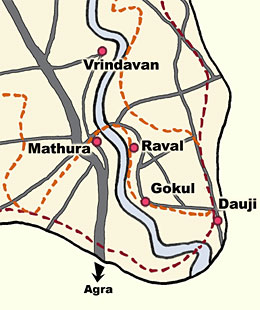 | It is located 135km south of Delhi and 55km north of Agra, just off the Delhi-Agra Road. It is 12 km or a 25 minute auto-rickshaw ride from Mathura. It is the heart of grater area called Braja-Mandala, the place of Lord Krisna's pastimes on this Earth 5000 years ago. |
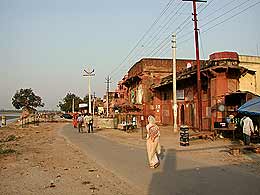 | The area of present day Vrindavan is actually the place of Krisna's rasa-lila pastime. There is a parikram-road around the town and some devotees are respectfully circumambulating Vrindavan every day. |
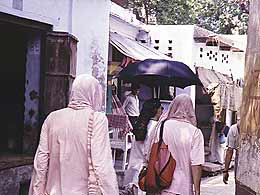 | Temples, shrines, ashrams, chipped walls, shops and bazaars - this is how the ancient town looks today. |
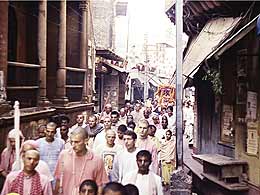 | Vrindavan is said to have 5000 temples and shrines of all different dimensions. One can walk around the town in about 2 hours, but to go through all streets and see all the altars may possibly take even years. Seven of the temples are most important. |
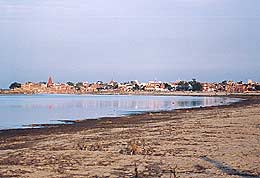 | Madanmohan of Sanatana Goswami.
Govindaji of Rupa Goswami.
Radha-Gopinath of Madhu Pandit Goswami.
Radha-Damodar of Jiva Goswami.
Radha-Syamasundar of Syamanada Pandit Goswami.
Radharaman of Gopal Bhatta Goswami.
Radha-Gokulananda of Lokanath Goswami. |
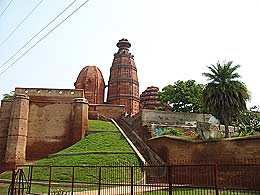 | Madanmohan Temple
Madanmohan means “one who can even enchant Cupid.” The Deity of Madanmohan (formerly Madan-Gopal) was made for Krisna's great grandson Vajranabha and for many years it was lost... |
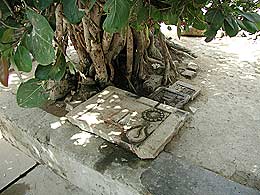 | Advaita Acarya discovered the original Deity of Madanmohan (Krisna) in Mahavan-Gokul and served Him here at the base of an old "vat" tree. Before His departure for Navadvip He entrusted the Deity to brahmana Chaubhe in Mathura. Years later Caitanya Mahaprabhu sent Sanatana Goswami to Vrindavan to discover lost places of Krisna's pastimes and write books about devotional service... |
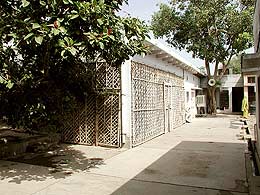 | Advaita Acarya performed his bhajana here at Advaita-vatat the base of the hill. |
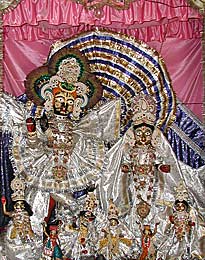 | Beautiful Deity at Advaita-vat. ...Sanatan used to beg in nearby Mathura and one day came to doors of the brahman Chaubha. He saw brahmana's children playing with the Deity as if Madanmohan was one of them. Horrified Sanatan chastised Chaubha and taught him proper ways of Deity worship. Both Sanatan and brahman had a dream that night. Madanmohan appeared to Sanatan and told him, that he liked to be treated as one of the brahmana's children and since Sanatan introduced so many rules, He don't like it any more... |
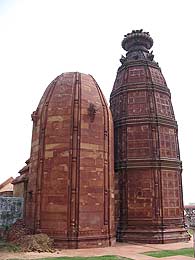 | ...To Chaubha Madanmohan said that he is like one of his children. He told him that he had many children and he should give Him to Sanatan. Next morning both devotees wanted to apologize, but at the end Madanmohan went with Sanatan. But not before He promised to Sanatan that He would be satisfied with whatever he will be able to offer. Sanatan, being traveling mendicant could not give much luxury to his Deities... |
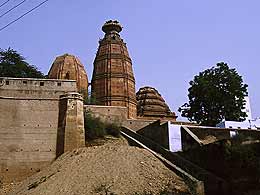 | Sanatana was practicing madhukari (begging from doors to doors) and he could offer to the Deity just dry bread balls... |
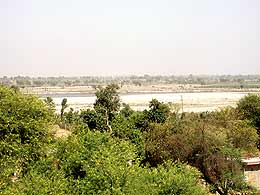 | ...Madan-Mohan asked him, if he could give Him at least little salt. Sanatana replied he would like to but being dedicated to his bhajan couldn't afford such a "luxury". Shortly afterwards down the Dvadasaditya Hill, the merchant's boat went aground in the Yamuna river... |
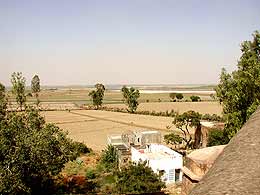 | ...The owner Krisnadas Kapoor was worried about his goods and didn't know what to do. Madan-Mohan took the form of small cowherd boy and led him upwards to Sanatana... |
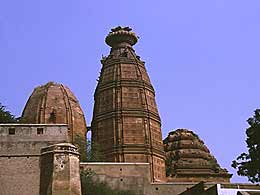 | ...Merchant described what happened, but Sanatan replied he couldn't do anything about it, being just a sannyasi. But he told him to pray to Madan-Mohan Deity he had kept just humbly roofed nearby... |
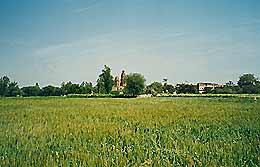 | ...The merchant did what Sanatan advised and few moments later his boat was released by rising of Yamuna's waters... |
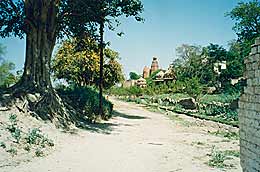 | ...Sailing down to Agra and making big profit, he later under Sanatana's direction began to construct temple for Madan-Mohan which became one of the symbols and dominant features of Vrindavan. |
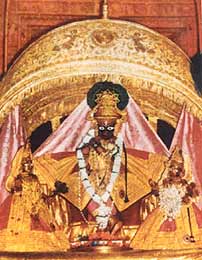 | Worshiped along with Madan-Mohan are Radharani and Lalita. They were sent to Vrindavan by Purusottam Sen, a disciple of Maharaja Prapatarudra. The original Madan-Mohan Deity was moved from Vrindavan to Jaipur when the Mughal Emperor Aurangzeb's soldiers attacked Vrindavan in 1670. That Deity is now in Karoli, which is southeast of Jaipur in Rajasthan. Original Madanmohan Deity in Karoli. |
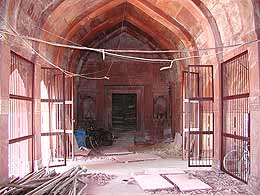 | Old kirtan hall temple altar where Madanmohan Deity was being worshiped. |
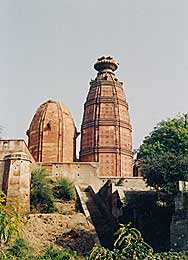 | There is a new Madanmohan Temple (right tower) built next to an old one (left tower), where the replacement Madan-Mohan Deity is now being worshiped. |
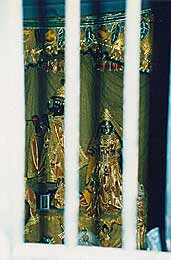 | Replacement or "pratibhu" Deities are considered as good as the original ones. Worship was moved to this new temple because the old temple was considered contaminated. |
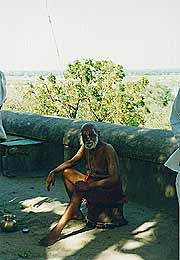 | Pujari is more than 100 years old. |
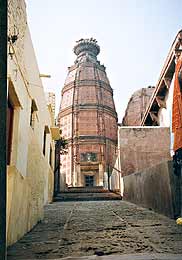 | The temple is presently state property, since it is considered to be historical sight. |
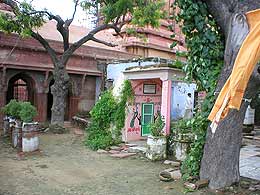 | Bhajan kutir of Sanatana Goswami
Sanatana Goswami was born into sarasvata-brahmana community in Bengal but was ostracized due to his acceptance of a ministerial post in the government of Hussain Sah. He served in the Muslim government and was high-ranking officer, but after meeting with Sri Caitanya Mahaprabhu he quit his post and was imprisoned by the Nawab... |
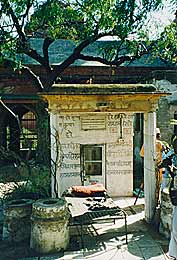 | ...With the help of some money left by hi brother Srila Rupa Goswami, he was freed from jail and fled from the country. Sanatana Goswami later met Sri Caitanya in Banares and was instructed by Him in the science of devotional service, bhakti-yoga... |
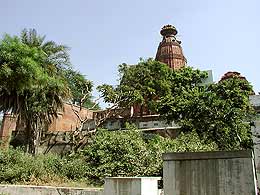 | ...Sri Caitanya told him to go to Vrindavan, write books about devotional service and rediscover the lost places of Krisna's pastimes. Before Goswamis came to Vrindavan, it was just lost forest. Vrindavan's glory was regained by the effort of great devotees of Sri Caitanya Mahaprabhu and especially by "Six Goswamis from Vrindavan". |
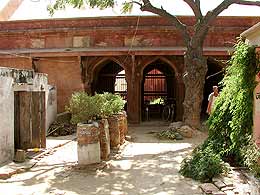 | Sri Sanatana Goswami is described in the Gaura-gandodesa-dipika (181). He was formerly known as Rati-manjari or sometimes as Lavanga-manjari. Manjaris are small girls - intimate maidservants of Srimati Radharani. |
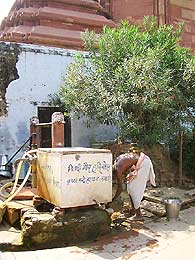 | Next to his bhajan-kutir, there is also sweet water well here that Sanatana Goswami used. Good sweet water is rare to found in Vrindavan area since it is mostly too mineralized and taste salty. From many wells it is not even advisable to drink. |
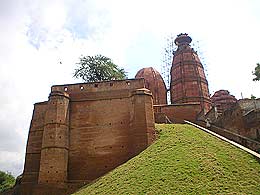 | Yoga-pith at Dvadasaditya Hill. |
 | Samadhi of Sanatana Goswami
There are several places throughout the Vraja area where Srila Sanatana Goswami performed his bhajana, but the last days of his life he spent at Govardhan Hill... |
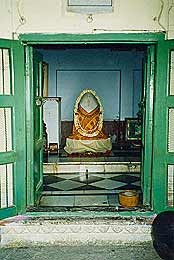 | ...He departed from this world on Guru Purnima, while residing at Govardhan... |
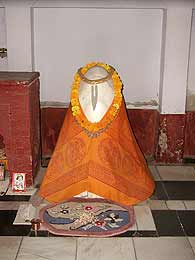 | ...His body was brought to Vrindavan and placed in samadhi behind the Radha Madanmohan Mandir. |
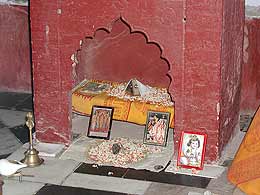 | Sila at his samadhi. |
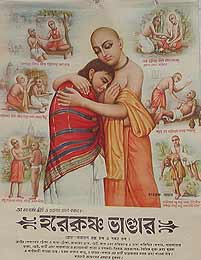 | Sri Caitanya meeting Sanatan. |
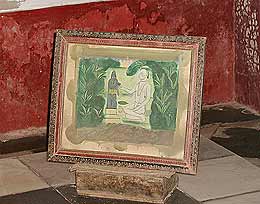 | "I am just a mendicant and cannot afford such a luxury." |
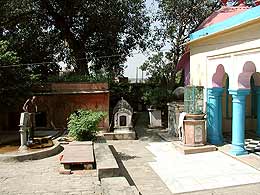 | In a nice proximity of Sanatana's samadhi are other important shrines. |
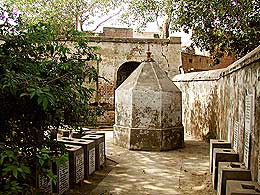 | Just behind his samadhi is grantha-samadhi, which contains some of the original manuscripts of the Goswamis... |
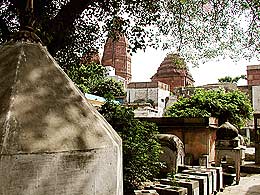 | ...Some of the books compiled by Sanatan Goswami were Hari-bhakti-vilasa, Brihad-bhagavatamrita, Dasama-tippani and Dasama-carita. |
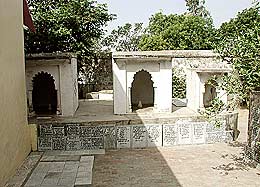 | In nice garden surrounding Sanatana's samadhi there are puspa-samadhis of Tapana Misra and Candrasekhara... |
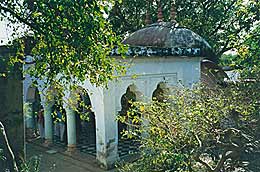 | ...They were close associates of Lord Caitanya. When Caitanya Mahaprabhu visited Benares, He stayed and took prasadam at their house. Tapana Misra was the father of Raghunath Bhatta Goswami. |
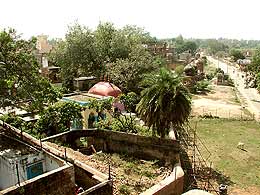 | Sanatana's samadhi in the garden just next to Dvadasaditya Hill. |
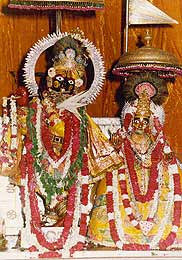 | Sri Sri Radha Govindaji
Sri Govinda was originally installed nearly 5,000 years ago by Lord Krisna's great-grandson. Govinda is one of the four presiding Deities of Braja-mandala. But for long time the Deity was lost... |
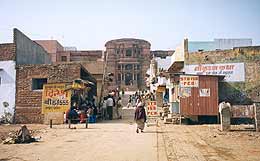 | ...Rupa Goswami, feeling separation because of being unable to find Deity of Govinda, sat under a tree on the bank of Yamuna... |
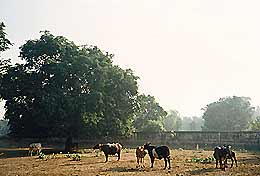 | ...At that time a beautiful young boy came and told him of a hill where a cow went every day and poured milk into a hole. The young boy then disappeared and Rupa Goswami went there... |
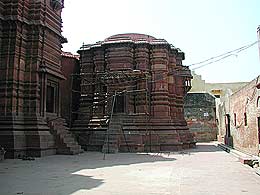 | ...He started to dig on that spot and discovered the Deity of Sri Govindaji. |
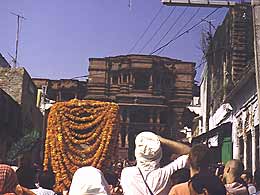 | Purusottam, the son of King Prapatarudra, sent the Deity of Radharani from Jagannath Puri to be installed next to Govindadev. This was first Deity of Radharani to be installed in Vrindavan... |
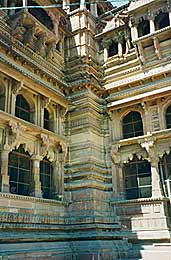 | ...This magnificent Krisna temple was built in 1590 by Maharaja Man Singh from Jaipur, a disciple of Raghunath Bhatta Goswami, and took several thousand men five years to build. He built it after meeting with Rupa Goswami and altar was made from marble, silver and gold... |
 | ...This temple was originally seven stories high and on the top there was burning gheelamp. Aurangzeb could see it shining even from his residence in Agra and sent his troupes to destroy it... |
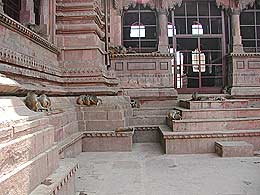 | ...When a few stories remained, all of a sudden the ground began to shake violently and Aurangzeb's men were terrified and run for their lives, never to return. Remnants of destroyed stories can be found around the temple. |
 | A sculptured lotus flower weighting several tons decorated the main hall. |
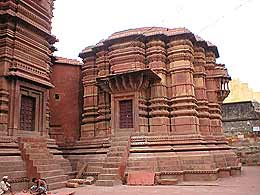 | There are two small temples on two sides of the Jagmohan, the main audience hall. |
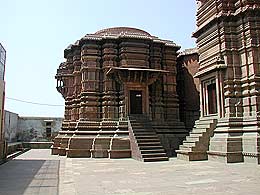 | Inside the small temple on the southern side, down 12 steps is a cave in which the Deity of Govinda was found and where Rupa Goswami used to meditate. A deity of eight-armed Yogamaya sitting on a lion is also there. There is also a stone slab with the footprint of Krisna on it. Vrindadevi, who is now in the town of Kamavan, used to be in the northern part of the temple. |
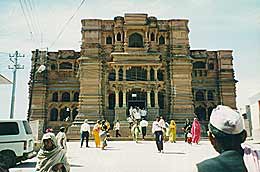 | Since this temple was partially destroyed by Muslims, it is considered that worship cannot be done in this temple. |
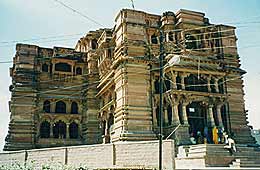 | Behind the temple, therefore, another temple was established where worship is performed to the Deities that were installed after Govindaji was removed and taken to Jaipur. |
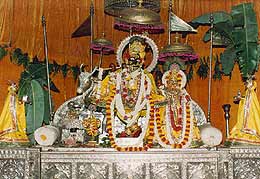 | Govindaji was brought to the city of Amber, near Jaipur, by Maharaja Jai Singh II to protect the Deity from destruction at the hands of the Muslim emperor about 1728 (some say 1735). |
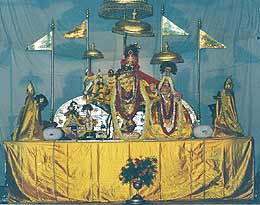 | Maharaja Jai Singh created his "City of Victory," the city of Jaipur, as a dedication to Lord Govindaji. The temple is in a garden of the palace complex, and when the temple doors were opened, Maharaja Jai Singh in the past could see his beloved Deity from the royal quarters. Jai Singh's grandfather had originally constructed the Govindaji Temple in Vrindavan. |
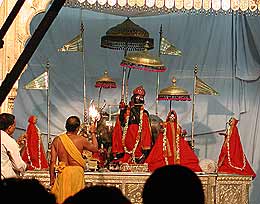 | Radha-Govinda Deity from Vrindavan is until today the real heart of the city of Jaipur. |
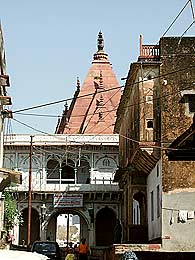 | Sri Sri Radha-Gopinath
It is said that Vajranabha, Krisna's great-grandson, had three Deities of Krisna carved. He never saw Krisna, so the Deities were carved according to the description given by Uttara, the mother of Maharaja Pariksit... |
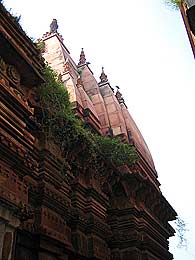 | ...He had three different images carved, but none of them were perfect. Govindaji resembled Krisna's face (Mukharavinda), Madana-Mohan resembled Krisna from the navel down to the lotus feet, and Gopinath resembled Krisna from the navel to the neck. |
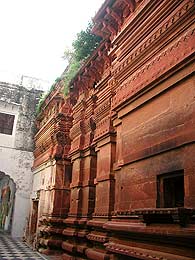 | In one book about the temples of Vrindavan, the Padma Purana is quoted saying that to get the full vision of Sri Krisna, pilgrims have to visit and offer obeisances to all three Deities during a single day, while the sun is still up... |
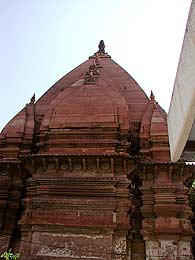 | ...Sri Govinda and Sri Gopinath are now in Jaipur, and Madana-Mohan is in Karoli, a small town in Rajasthan and this triple darsan seems to be possible even today, if you are efficient traveler, of course... |
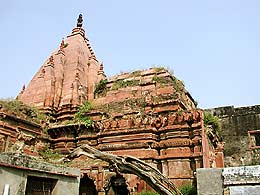 | Radha-Gopinath are the Deities worshiped by Madhu Pandit Goswami and discovered at Vamsivata in Vrindavan by Paramananda Bhattacarya, the disciple of Gadadhar Pandit. Vajranabha originally installed Gopinath in Vrindavan. This Deity was brought to Jaipur from Vrindavan when the Muslims raided Vrindavan. |
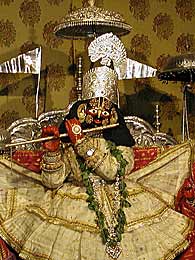 | Original Radha-Gopinath Deity at Jaipur. |
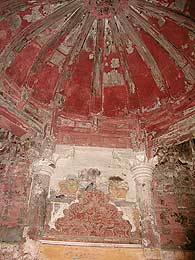 | The chapel of the old temple. |
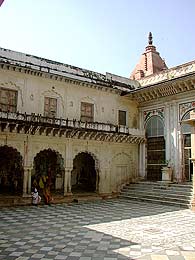 | This temple was also desecrated by Aurangzeb in 1670... |
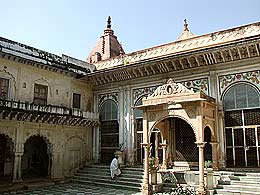 | ...and new one was built next to it... |
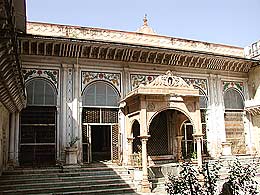 | ...where pratibhu-murti is worshipped today. |
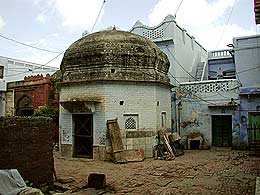 | Samadhi of Madhu Pandit Goswami.
Madhu Pandit was a disciple of Gadadhar Pandit. He established the temple of Gopinath in Vrindavan and lived here until his sacred body was entombed here... |
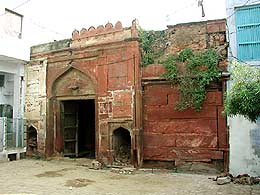 | ...near the original main gate of the Gopinath temple. |
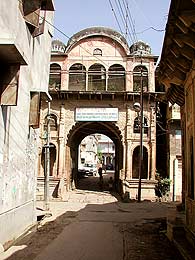 | Present day gate of Radha-Gopinath Temple. |
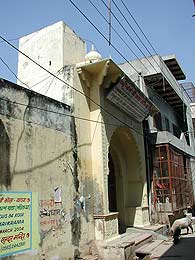 | Radha-Damodar Temple
was founded by Srila Jiva Goswami, nephew of Rupa and Sanatana Goswami. He was son of Annupam. Sadhana-dipika mentions that Sri Rupa Goswami had many skills. He could carve Deities, draw, he was expert astrologists and fluent in Sanskrit, Bengali, Persian and other languages. In Karttik 1542 Sri Rupa, knowing Jiva's desire for the Deity, personally carved, installed and offered a small Deity of Damodar to his foremost disciple. Eight inches high Lord Damodar came from a piece of black marble brought from Vindhya Parvat in central India... |
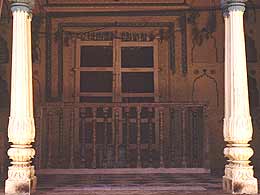 | ..."Dama" means "rope" and "udara" is "abdomen". Damodar is a form of Krisna who is being bound by the ropes of mother Yasoda because He broke the yogurt and milk pots like the ordinary naughty boy... |
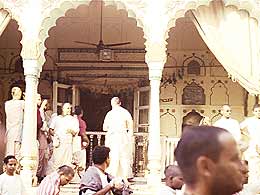 | This temple was built for Jiva Goswami by Maharaja Man Singh from Jaipur (Ambra). On the left you can see opened altar. The temple room is actually roofless courtyard... |
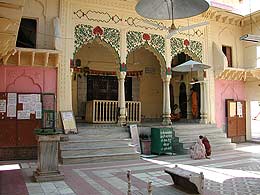 | ...Other Deities worshiped here are the Radha Vrindavan-candra Deities worshipped by Krisnadas Kaviraj Goswami, the Radha-Madhava Deities of Jayadev Goswami, and the Radha-Chalacikana Deities of Bhugarbha Goswami. The original Deities were all moved to Jaipur... |
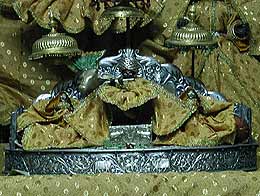 | Original Radha Damodar Deities made by Rupa Goswami for Jiva (Jaipur) |
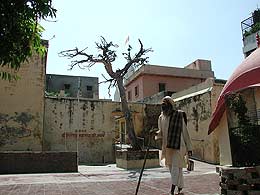 | There is a Govardhan-sila in this temple that was worshiped by Sanatana Goswami. It has Lord Krisna's footprint on it, and it was given to Sanatana Goswami by Krisna Himself. Sanatan was getting old and couldn't circumambulate whole Govardhan any more (21 km)... |
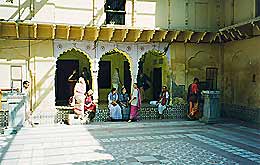 | ...Lord Krisna gave him this sila and told him that circumambulating this sila is as good as circumambulating the whole Govardhan Hill. For a small donation the pujari will show you this sila. You can see the imprints of Krisna's footprint, walking stick, flute, and the hoof-print of a calf imbedded in the sila. |
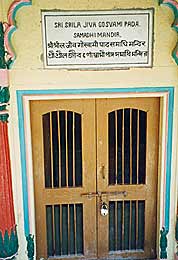 | Samadhi of Jiva Goswami.
Turning to the left entrance from the temple room, one goes into another courtyard. There one can find samadhi of Srila Jiva Goswami. In Gaura-gandodesa-dipika it is stated that he was actually Vilas Manjari. He was very found of Srimad-Bhagavatam even from his childhood and went to Navadvip to study Sanskrit. Nityananda Prabhu was his guide during Navadvip-parikram. After further studies in Benares he went to Vrindavan to help Rupa and Sanatan... |
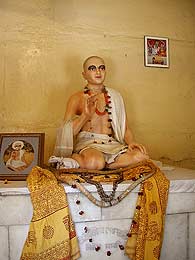 |
...After their departure he was adviser and acarya of all devotees. Jiva Goswami consolidated the works of his uncles Rupa and Sanatana Goswamis and compiled twenty five books of over 400 000 verses. Srila Prabhupada writes: "To understand Lord Caitanya, one has to follow the direst descendants of Lord Caitanya - the Six Goswamis - and especially the path chalked out by Srila Jiva Goswami." Later he sent the next generation of Vaisnavas (Srinivas, Narottam and Syamanada) to preach to Bengal with a cart full of books written by Goswamis.
|
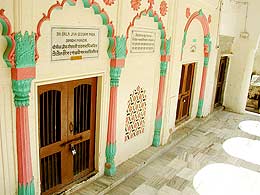 | Jiva Goswami consolidated the works of his uncles Rupa and Sanatana Goswamis and compiled twenty five books of over 400 000 verses. Srila Prabhupada writes: "To understand Lord Caitanya, one has to follow the direst descendants of Lord Caitanya - the Six Goswamis - and especially the path chalked out by Srila Jiva Goswami." Samadhi of Jiva Goswami (left) and Krisnadas Kaviraj Goswami (right). |
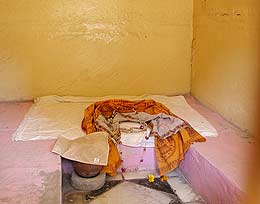 | Samadhi
of Krisnadas Kaviraj Goswami
Krisnadas Kaviraj Goswami is the author of celebrated classic Sri Caitanya-caritamrita. Once, Sri Nityananda appeared to him in a dream and told him to go to Vrindavan. He became disciple of Raghunath das Goswami and lived near his spiritual master at Radha-kund. In 1581 he completed Caitanya-caritamrita and one year later he entered samadhi. Krisnadas Kaviraj Goswami is and incarnation of Kasturi Manjari, Radharani's maidservant. |
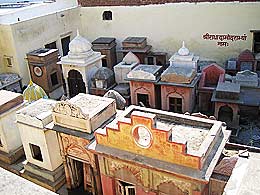 | There are whole roads of different shrines and samadhis... |
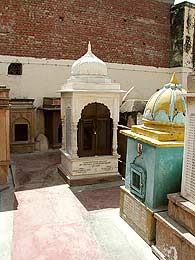 | Puspa-samadhi of Bhaktisiddhanta Sarasvati... |
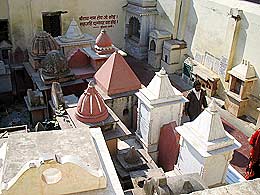 | ...and puspa-samadhi of the king Birhambir who became Srinivasa's disciple and transformed his kingdom into Vaisnava state and other vaisnava saints. |
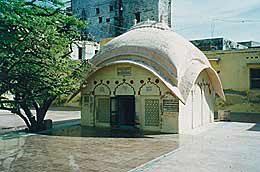 | Samadhi of Srila Rupa Goswami
is on another courtyard right to the altar. |
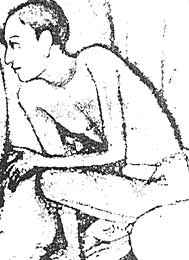 | In Gaura-gandodesa-dipika Sri Rupa Goswami is described as gopi named Rupa-manjari - young personal maidservant of Srimati Radharani. On the order of Sri Caitanya Mahaprabhu Rupa Goswami wrote many books about the Vaisnava philosophy. Possibly the most famous of them is Bhakti-rasamrita-sindhu, translated into English as "Nectar of Devotion". Rupa Goswami is protector and leader of devotees and his followers call themselves "rupanugas". We can pray at his samadhi for his mercy so that at least little bit of transcendental glory of Vrindavan will be revealed to us. |
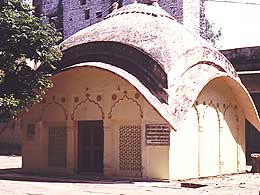 | This is how his samadhi looked in 90ties (there was no marble floor yet). |
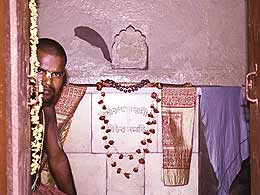 | Inside the samadhi in 1992... |
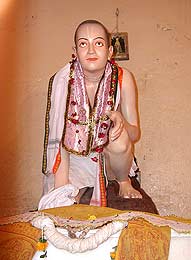 | ...and in 2004. |
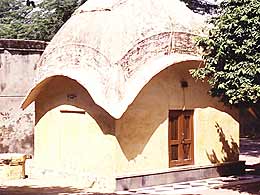 | Bhajan-kutir of Srila Rupa Goswami
is just next to his samadhi. |
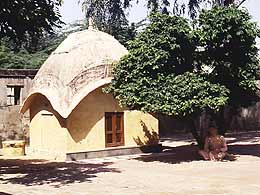 | Between them there is sacred tamal tree. Tamal trees are very rare, hardly growing anywhere expect Vrindavan area. Their blackish bark resembles dark complexion of Lord Krisna. Gopis in time of intense fear or separation from their Lord began to embrace Tamal trees to get feeling of safety and His closeness. |
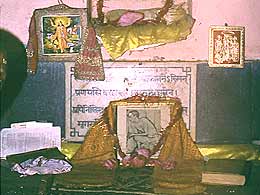 | Inside bhajan-kutir is small humble altar. |
 | In his last days Rupa Goswami gave all the manuscripts to Jiva Goswami, requesting him to write the commentaries. In 1564, on Sravan-dvadasi-pavitra, Sri Rupa Goswami entered samadhi. Jiva Goswami placed his transcendental body to his samadhi mandir, where it stands now... |
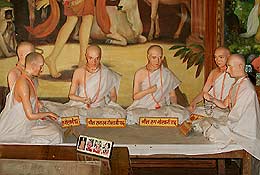 | ...On that most holy day, the Goswamis, Raghunath Bhatta, Gopal Bhatta, Raghunath das and all the Vaisnavas in attendance proclaimed to Jiva Goswami: "From this day on, you are our master, and our leader." |
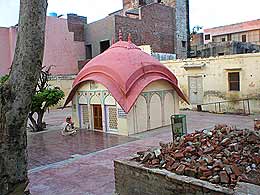 | Shortly after Rupa's disappearance, Jiva Goswami established a "Visva Vaisnava Raja Sabha", a type of school or formal assembly to tech Sanskrit based on his own Hari-nama Vyakarana and the bhakti granthas of the Goswamis Bhakti-rasamrita-sindhu (Rupa Goswami), Brihad-bhagavatamrita (Sanatan Goswami) ad Ujjvala-nilamani. Jiva Goswami was the most systematic preacher, and was soon acclaimed as the greatest philosopher in all of India. |
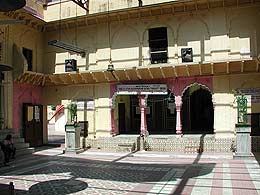 | Although Radha-Damodar temple was not large and ornate, it was once famous for its vast library, where Jiva Goswami neatly stored all the original manuscripts of the Goswamis. |
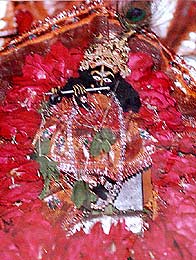 | In 1670 demoniac Moghul Emperor Aurangzeb ruthlessly attacked Vrindavan Temples. Raiders, mistaking it for the private residence, didn't defile the simple designed Radha-Damodar temple. But the Deities were moved to Jaipur before that. The temple priests implored the Jaipur king to return Deity and after a sixty-nine years in Jaipur, Radha-Damodar came home to Vrindavan. The Lord did not stay long, however, because a determined Maharaja Jai Singh prevailed upon Damodar's priests to allow the Deity to move back to Jaipur, where He remains today. |
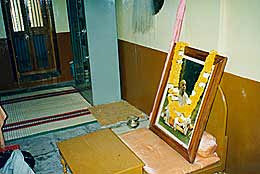 | Prabhupada's rooms
On the right side of the temple courtyard there are two rooms where Srila Prabhupada lived before his departure to America. |
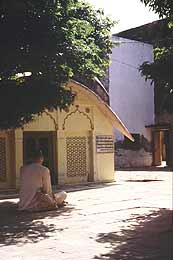 | His small kitchen has a window (on the white wall behind) overlooking the samadhi of Srila Rupa Goswami. |
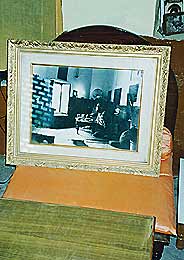 | Srila Prabhupada often said he received great inspiration from Rupa Goswami. |
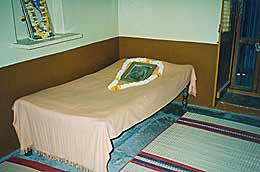 | Simple living place of "Swami who is always writing", how local people started to call him. |
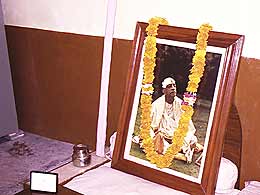 | The worship in those rooms is carried out by Prabhupada's disciples. We got invited by Smita-krisna Maharaja who served us wonderful feast prepared for Prabhupada. Afterwards he cleaned everything saying he is now Prabhupada's servant and we are his guests. We could hardly imagine better welcome to Vrindavan... |
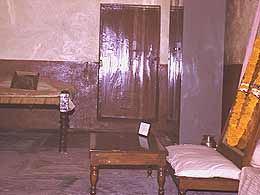 | Srila Prabhupada lived here for nearly 6 years. He wrote and traveled to Delhi to publisher. |
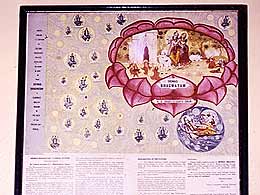 | He was finishing the commentary to the first canto of Srimad-Bhagavatam. This part was published in India before his departure. |
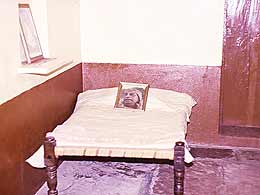 | "I eternally reside in my rooms at the Radha-Damodar Temple," said Srila Prabhupad many times. |
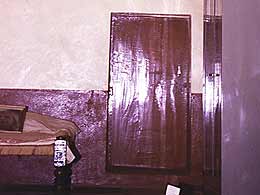 | "When Krisna descended on the earth, He appeared in Vrindavan. Although I am presently living in America, my residence is in Vrindavan, because I am always thinking of Krisna. Although I may be in a New York apartment, my consciousness is there, and this is as good as living there."
Path of perfection, p.128 |
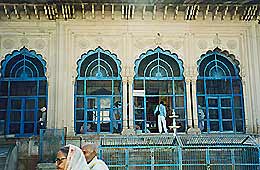 | Radha-Syamasundar Temple
This temple was established by Syamananda Prabhu during his second visit to Vrindavan... |
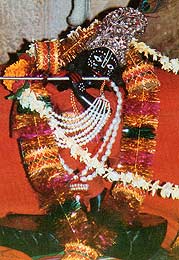 | The original Deity given to Syamananda by Srimati Radharani can be seen to the right of the altar. |
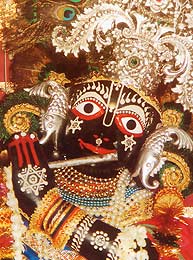 | Extremely beautiful Radha-Syamasundar Deity... |
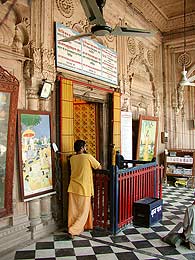 | ...were also worshipped by gaudiya-vedantacarya Baladev Vidyabhusana... |
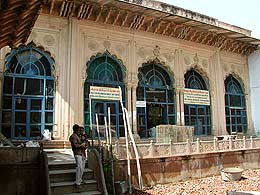 | ...Baladev Vidyabhusana was born in a village near the famous Remuna in Orissa. He studied rhetoric, logic and Sat-sandarbhas under Sri Radha-Damodar, a disciple of Rasikananda Prabhu. Later he studied Srimad-Bhagavatam under Visvanath Cakravarti Thakur and under his instruction he went to Jaipur... |
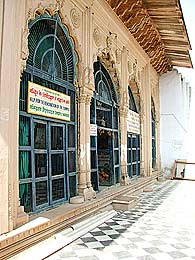 | ...Visvanath Cakravarti, being too old to travel, send is most brilliant student to defend gaudiya-sampradaya, because pandits from Ramanuja-sampradaya wanted to take over the worship of famous Govindaji Deity in Jaipur. At the well-known Galta in Jaipur he defeated opponents of the gaudiya line and established vigraha of Sri Vijay Gopal. He composed a commentary on Vedanta-sutra called Govinda-bhasya because it was dictated to him by Lord Govindadev Himself. He reinstalled Sri Radha besides Sri Govindaji... |
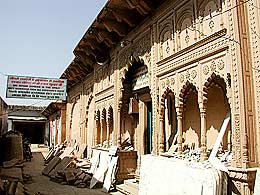 | ...He also wrote other books, that are treasured as a gems in gaudiya-vaisnava tradition: Siddhanta-ratnam, Vedanta-syamantaka, Prameya-ratnavali, Siddhanta-darpana and commentary on Sad-sandarbha. |
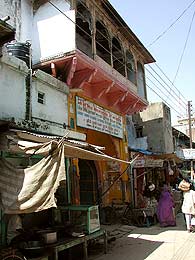 | Entrance gate of Radha Syamasundar Temple. |
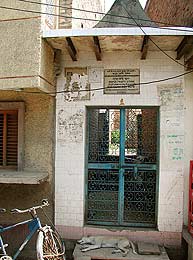 | Puspa-samadhi of Syamanada Pandit is little further towards Radha-Damodar Temple opposite the entrance gate. |
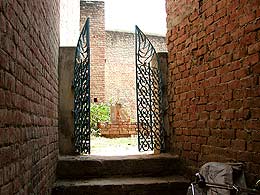 | Syamanada's former name was Duhkhi Krisnadas. One day he was sweeping the ground and found an anklet. A small girl came looking for it, claiming it to belong to her sister. He refused to give it back to anyone but the owner and the girl left... |
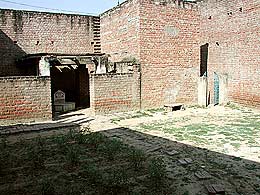 | ...The small girl was actually Lalita-sahki and returned short time later with Srimati Radharani Herself. Radharani blessed Krisnadas with the anklet and pressed it against is forehead, creating permanent tilak mark... |
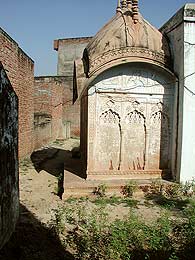 | ...Vaisnava devotees later criticized Duhkhi Krisnadas for his unusual tilak, but only until the time when Radharani appeared to Jiva Goswami in a dream and explained everything to him. Jiva Goswami thus renamed Duhkhi Krisnadas (literary "unhappy Krisnadas") to Syamananda. |
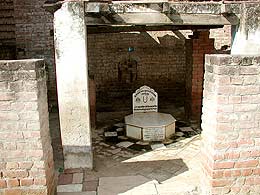 | Syamananda Tilak-sthan. |
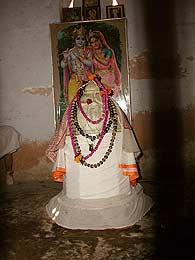 | Puspa-samadhi of Syamananda Pandit. |
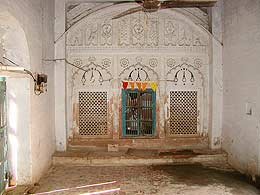 | Syamananda Pandit Goswami was no other than Kanaka Manjari, one of the Srimati Radharani's intimate maidservants. |
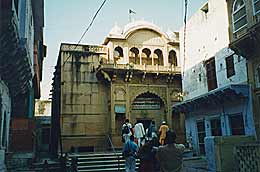 | Sri Radharaman Temple
was established by Gopal Bhatta Goswami. |
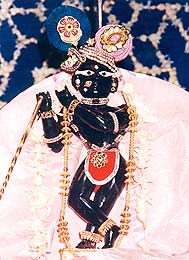 | Radharamana's lotus face is like Sri Govindaji's, His chest is like Sri Gopinath's and His lotus feet are like Sri Madanmohanji's. By taking darsan of Radharaman one receives the simultaneous darsan of these three Deities. |
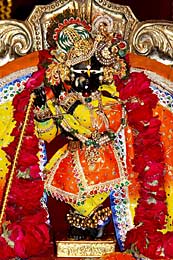 | The Deity of Sri Radharaman was manifested from one of Gopal Bhatta Goswami's salagram-silas on the full moon day of Vaisakha (April/May) in 1542. worshipped along with a salagram-sila. |
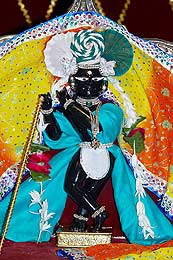 | This event is celebrated every year (May) by bathing the Deity with 100 liters of milk and other auspicious items. Gopal Bhatta Goswami's other salagram-silas are also worshiped on the altar. |
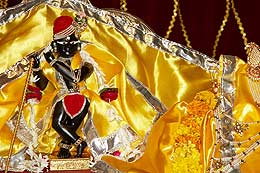 | There is no Deity of Radharani with Radharaman, but gomati-cakra is worshipped on the altar to His left. According to an injunction of Sri Hari-bhakti-vilas, a gomati-cakra is to be worshipped along with a salagram-sila. |
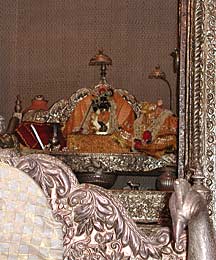 | Radharaman is one of the few original Deities of the Goswamis still in Vrindavan. Other Deities went to Jaipur, but Radharaman never left Vrindavan. The fires for cooking in the temple kitchen have been burning continuously for over 435 years, since the Deity was installed. This is so no foreign elements, such as matches, are used for ignition purposes. |
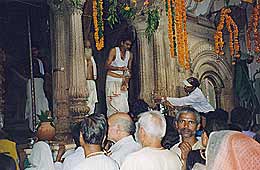 | The standard of worship at samadhi and temple is exemplary and Srila Prabhupada wanted his disciples to learn Deity worship from local pujaris. |
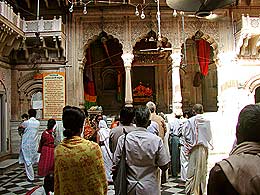 | Sri Caitanya Mahaprabhu's kaupina (cloth) and asana (seat), which Gopal Bhatta Goswami brought from Jagannath Puri, are also in this temple. They are brought out to be seen by the public three or four times a year. The asana is black wood and is about 30 cm (12") by 25 cm (10"). |
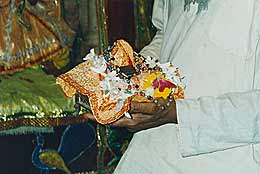 | Govardhan-sila of Sri Caitanya Mahaprabhu. |
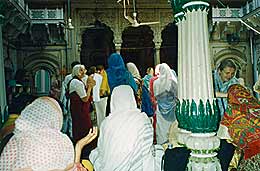 | Before large temples were built, the Goswamis worshiped their Deities simply, keeping them in a tree under which they slept... |
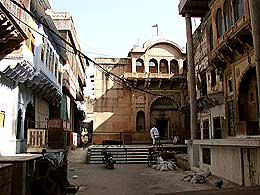 | ...Radha-raman Deity was adored in a tree for centuries. In the area of the present Radha-raman temple, there used to be a large lake, connected to the Yamuna river... |
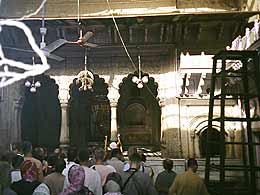 | ...For a couple of hundred years they worshiped Radha-raman in a tree, and at night put him in a boat anchored in the middle of a lake... |
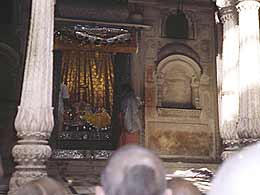 | ...They stood guard with bows and arrows, if anyone came to hassle the Deity. Even today, they have the bows and arrows in the temple. |
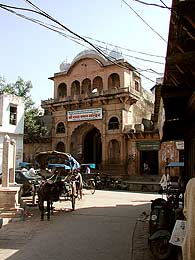 | Besides daily puja there are other festivals held at the samadhis. Upon taking initiation into Gaudiya-vaisnava Sampradaya, a new disciple may sponsor a special uttsava (festival) consisting of hari-nama sankirtana (chanting of the name of the Lord), bhagavatha-katha (discourses about the Lord) and offer an opulent feast of prasadam to present Vaisnavas and Braja-vasis (residents of Vrindavan). |
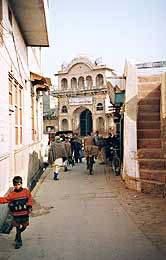 | Outer Gate of Radha-raman Temple is close to the Nidhivan garden. |
 | Radharaman Temple was not attacked by Aurangzeb's soldiers because they mistakenly thought it to be just residential quarter. |
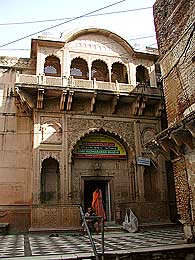 | Inner entrance to the Temple. |
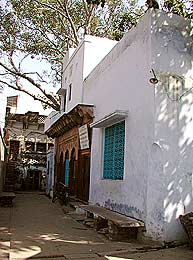 | Gopal Bhatta Goswami's samadhi is to the left after you enter the first gate from the street into the temple compound. Gopal Bhatta Goswami was the son of Vyenkatta Bhatta, a brahmana priest of Srirangam Temple in Tamil Nadu. His uncle Prabhodananda Sarasvati also became his spiritual master. In 1511 Sri Caitanya Mahaprabhu visited Srirangam a danced in ecstasy before Lord Ranganath... |
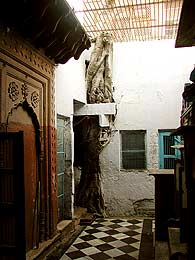 | ...Vyenkata Bhatta invited Lord Caitanya to stay at his house during Caturmasya. Gopal Bhatta was at that time small boy and got the chance to serve the Lord and hear directly from Him. After some time Lord Caitanya left on his tour to South India and told Gopal Bhatta to go in the future to Vrindavan... |
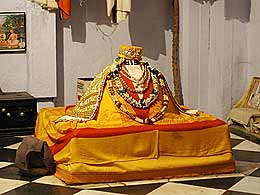 | ...Gopal Bhatta became learned in Sanskrit, poetry, rhetoric and all aspects of devotional service. After passing of his parents, he left home and proceeded towards Vrindavan where he joined Rupa and Sanatan... |
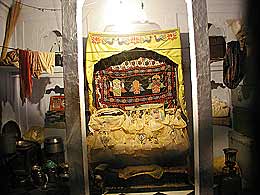 | ...After some time studying in Vrindavan Gopal Bhatta made a trip to Nepal. One day when he was taking bath in Kali-Gandakini river, he dipped his kamandalu into the water and 12 silas mysteriously entered his water pot... |
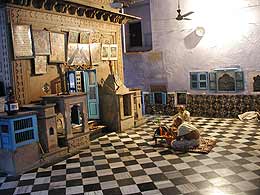 | ...He put them back into the water and dipped the kamandalu again in the water of the holy river, but the silas again entered his water pot... |
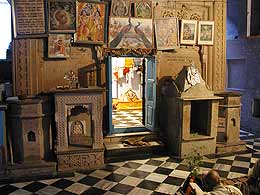 | ...When it happened for the third time, Gopal Bhatta realized, that those are not ordinary stones, but they must be some very special ones and there must be some divine arrangement behind it. He kept them in a cloth bag hung around his neck and from that time on he started to worship them and returned to Vrindavan... |
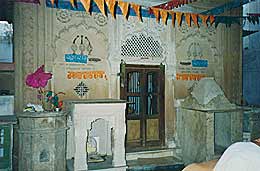 | ...Once he intensely desired to decorate his salagram, seat Him on a swing and serve Him as other devotees can. "If only He had arms and legs like a Deity," he thought... |
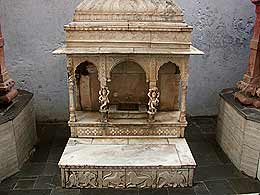 | ...Lord Krisna, being very kind to His devotees, that very night transformed Himself from one of small salagram-sila into threefold form of Radharaman. If one has darsan of Radharaman's back, one will see that it resemble salagram-sila. Although the Deity is quite small many devotees find Him to be extremely attractive. |
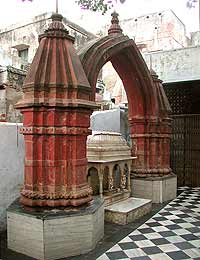 | The appearance place of the Sri Radharaman Deity is next to the temple besides Gopal Bhatta's samadhi. |
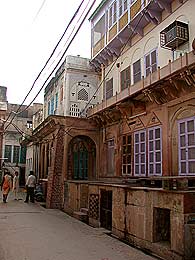 | Gopal Bhatta was actually originating the Sat-Sandarbhas, later elaborately developed by Jiva Goswami, he also edited Hari-bhakti-vilas. His most prominent disciple was Srinivas Acarya. |
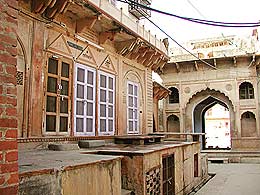 | Gopal Bhatta Goswami was no other than Ananga Manjari, one of the eight intimate maidservants of Srimati Radharani. |
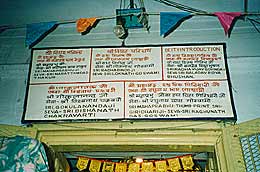 | Radha Gokulananda Temple
was founded by Lokanath Goswami. The entrance to the temple is on the same street as Radharaman Temple. |
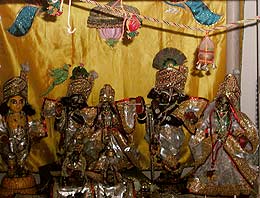 | In this temple you can see the Radha-Vinod Deities of Lokanath Goswami, Radha-Gokulananda Deities of Visvanath Cakravarti, Caitanya Mahaprabhu Deity of Narottam das Thakur, Vijaya Govinda Deities of Baladev Vidyabhusana, and the Govardhan-sila given to Raghunath das Goswami by Sri Caitanya... |
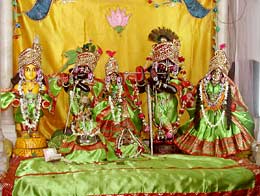 | ...Original Deity of Visvanath Cakravarti is the small one in the front. Other Deities are pratibhu-murtis. |
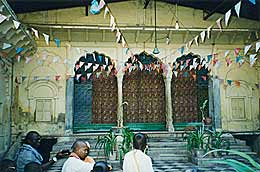 | Caitanya Mahaprabhu gave a govardhan-sila to Raghunath das Goswami, and this can be seen if one offers a small donation. The sila bears the thumbprint of Lord Caitanya, who used to chant while holding the sila, pressing it to His heart or eyes... |
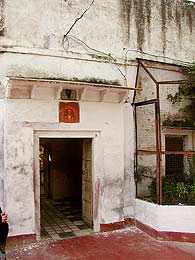 | ... Sometimes He would smell it or place it on His head. The stone was almost always moist with Lord Caitanya's tears. Sri Caitanya Mahaprabhu would say: "This stone is directly the body of Lord Krisna." Sri Caitanya kept the sila for three years and than gave it to Raghunath das, being greatly satisfied by his behavior. Visvanath Cakravarti also worshipped for some time Raghunath's govardhan-sila. |
 | The samadhi of Lokanath Goswami.
Lokanath Goswami was a contemporary of Sri Caitanya Mahaprabhu and when the Lord took sannyas, Lokanath came to Vrindavan with Bhugarbha Goswami and performed very strict bhajana. He was always meek and humble. When young Narottam das came to Vrindavan to study under the Goswamis, he was attracted by this saintly person... |
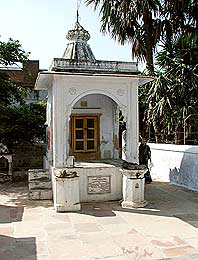 | ...Lokanath, however, did not want to accept disciples and refused repeated requests from Narottam. But Narottam was very determined. He acted as menial servant of Lokanath Goswami, who was finally pleased by his behavior and accepted him as his only disciple. |
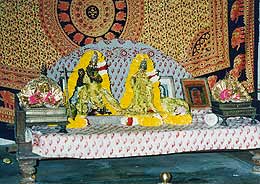 | Lokanath Goswami found Deity of Radha-Vinod (Vinodial) in Umaro Gaon near Chatravan. Upon request of Rupa, Sanatan and other Goswamis he brought the Deity to Vrindavan. Vinodilal is a beautiful Deity about 30cm tall. On the left we can see the original Deities now worshipped in Jaipur. |
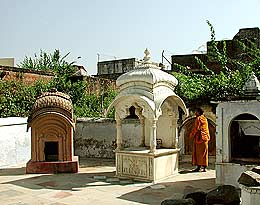 | In the courtyard of Radha-Gokulananda Temple besides Lokanath's samadhi there are samadhis of Visvanath Cakravarti Thakur (left), puspa-samadhi of Narottam das Thakur (center) and samadhi of Ganganarayan Cakravarti (right). |
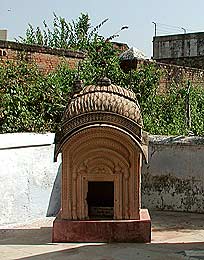 | Visvanath Cakravarti was the greatest acarya of seventeenth century. His guru Radharaman Cakravarti asked him to copy Srimad-Bhagavatam in his home and while writing he entered into trance. He wrote day and night. Even though the sun was scorching, the spot where he sat was as if by miracle shaded. Another day started to rain, but on Visvanath no rain fell. The local landlord saw this miracle and told to townspeople much to Visvanath's embarrassment. After some time his spiritual master ordered him to live at Radha-kund and write books... |
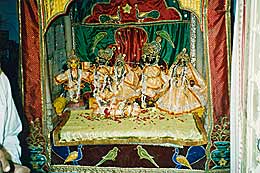 | ...One brahmacari from Mathura had a dream in which the Lord appeared to him and asked him to give his small Gokulananda Deity to Visvanath. He did so, but Visvanath refused to take the Deity because he could not afford proper worship. That night the Lord appeared to Visvanath and told him that He would arrange everything necessary for the offerings. The brahmacari had another dream and this time, Visvanath accepted. |
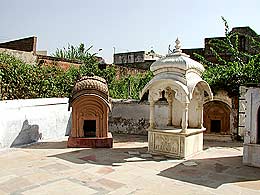 | After the disappearance of Jiva Goswami a controversy aroused among his followers. Some believed that Radha and Krisna are eternally married (svakiya-rasa) and should not be worshipped as paramours in parakiya-rasa. In order to accommodate neophytes Jiva Goswami acknowledged svakiya-rasa in his book Ujjvala-nilamani, but his followers failed to see that in his other books he wrote about parakiya-vada as thought by Lord Caitanya Himself... |
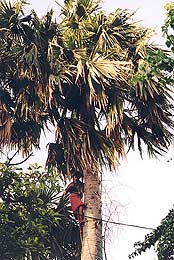 | ...Visvanath Cakravarti defeated the controversy, but the pundits got angry and plotted to kill him. They waited for him in secluded place for a long time, but he was not coming. Suddenly they saw a very beautiful young girl picking flowers and they were completely enchanted by her beauty. They forgot their enmity towards Visvanath and asked her who she was. The girl replied she is the maidservant of Sri Radha and he is collecting flowers so that Sri Radha could make a garland for Her beloved paramour. Sri Krisna. Upon saying this the girl disappeared and the scholars saw only Visvanath sitting there... |
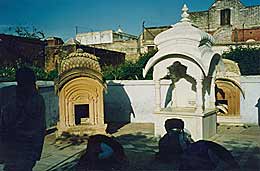 | ...Visvanath than asked them what place lies between Varsana and Nandagram. "Sanket," they replied.
"Why than Radha meets Krisna at Sanket rather than at Krisna's home at Nandagram? If the Divine Couple were actually married, they could easily meet at His father's home at Nandagram. Instead They meet at Sanket, the place of Yogamaya, who arranges Their meeting." Shortly after that those scholars became Visvanath's disciples. |
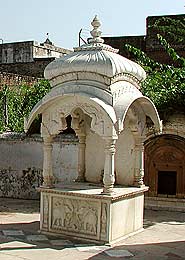 | Narottam das Thakur was born in Khethuri in 1534, the year of Lord Caitanya's disappearance. His father was king, but by caste he was kayastha (sudra). Before that, when Sri Caitanya visited Ramakeli, He went to River Padma and suddenly began to call out: "Narottam!" "Narottam!" He told His devotees: "Very soon a personality will be born in Khethuri and he will absorb My kirtana-rasa with all of my love. Now I am depositing my prema to Padma and she will deliver it to Narottam..." |
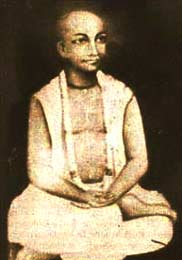 | ...Young Narottam became brilliant student and one day Lord Nityananda appeared to him in a dream and told him to go to river Padma and take bath. On waking Narottam rushed towards the river and while bathing his body have changed from blackish to golden. Narottam started to call and cry and upon returning his parents could not recognized him. He was dancing and singing the holy names day and night. After some time Narottam had a dream in which Sri Caitanya ordered him to go to Vrindavan and take initiation from Lokanath Goswami. Narottam run away from home much to the despair of his parents... |
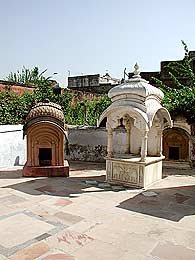 | ...Upon arriving to Vrindavan he fainted in front of Govindaji and all devotees headed by Jiva Goswami came there to meet him as Sri Caitanya predicted his appearance. Narottam became the only disciple of Lokanath Goswami and his bhajans are famous among vaisnavas even today. Srila Prabhupada said that even stones are getting melted listening to Narottam's bhajans. This puspa-samadhi contains his garland, cloth, kaupin and japa beads. Narottam das Thakur is Vilas Manjari, one of the Radharani's intimate maidservants who usually prepares milk products. Narottam's body is not entombed anywhere since his transcendental body dissolved as milk into the water during his bath in a river at his disappearance. |
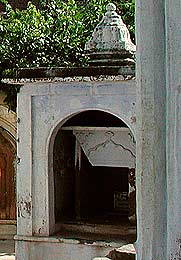 | Ganganarayan Cakravarti
was a prominent disciple of Narottam das Thakur. He was high caste brahmana by birth and smarta-brahmanas at those times strongly protested against Narottam (sudra by birth) initiating brahmanas and convinced the king to challenge Narottam. When Ganganarayan heard that king's party is approaching, he and Ramacandra Kaviraj disguised themselves as clay pot seller and betel nut seller. Shortly afterward smarta-pandits went shopping clay pots for cooking and were amazed that shopkeepers in this town speak fluent Sanskrit... |
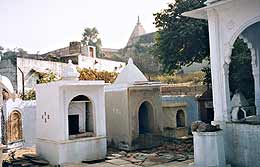 | ...They have got into debate and clay pot walla and betel nut walla defeated them in argument. Perplexed reported it to the leader of the party and told him: "If shopkeepers in this village defeated us in debate, only God knows what will happen when we will meet the guru himself!" Ganganarayan Cakravarti in this way protected Narottam from this disturbance. That night the king and the Digvijai-pandit had a dream that they should accept initiation from Narottam. |
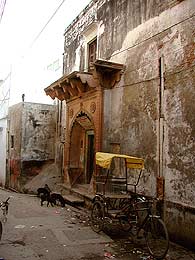 | The entrance door to Radha-Gokulananda Temple is on the same street as Radharaman Mandir. |
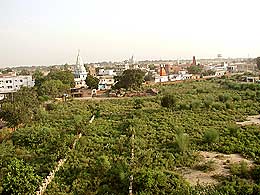 | After getting to know about main seven temples established by Goswamis we will perform parikram around the town and in the next round we will visit other places inside the town area. |
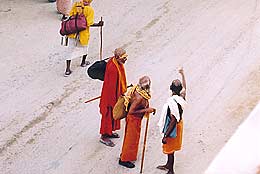 | Detailed map of Vrindavan with most places of interest can be found at the end of this page. |
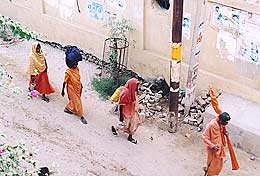 |
Vrindavan-parikram
Circumambulating Vrindavan by foot can be made in two or three hours, provided on does not stop in many places.
|
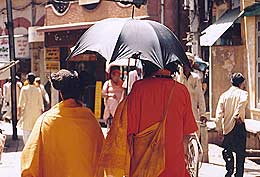 | Since it is not our case and it will take us a lot more, it is therefore wise to take an umbrella providing a shade. |
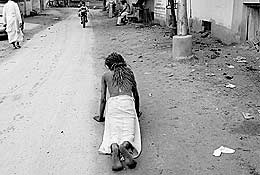 | Parikram of course, can be made in many ways - for instance as a reverential tapasya. |
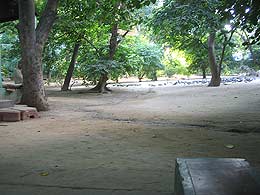 | Vrindavan-parikram can be started at any place on parikram road going clockwise. |
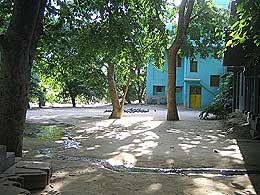 | We start our journey at Ramana-reti where Krisna and Balaram performed Their pastimes, just next to Radha-tilawhere Radharani's parrots gather every evening in numbers. |
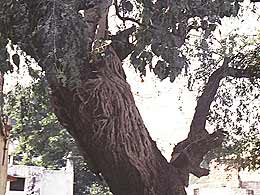 | Our first stop is Krisna-Balaram tree. Balaram (with white complexion) sits on Krisna's (blackish) neck, as the white tree grows from the dark tree. |
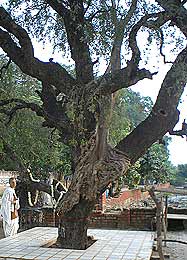 | But the whitish tree is drying up (2004). |
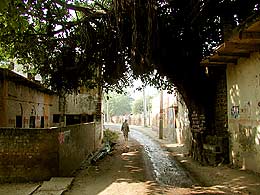 | Varaha-ghat
Formerly Yamuna river used to flow here... |
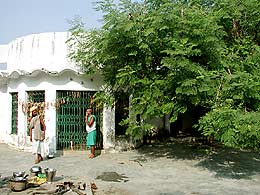 | ...and at this place Krisna showed His Varaha form to the gopis... |
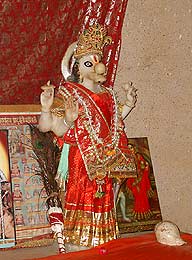 | Beautiful Varaha Deity at Varaha-ghat. |
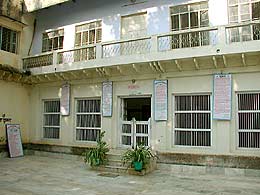 | Gautama Muni asram
is just opposite to Varaha-ghat on parikram path... |
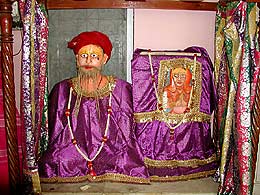 | ...Here great sage Gautama Muni performed austerities many thousands years ago. |
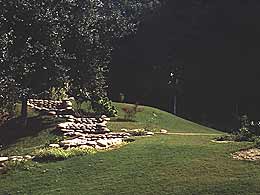 | Few plots of land are cultivated attempting to restore some of the former beauty of Vrindavan of Krisna's times. This plot is quite near the river, but to pump water for irrigation from areas further from Yamuna river can be more harmful than beneficial. In this way the level of the underground water would drop even lower and the trees would get even harder time in worm Vrindavan summer. We shouldn't forget that Vrindavan area is near Rajasthan desert, which is growing partially due to cutting of the trees. |
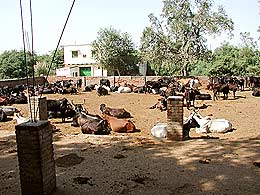 | Go-ghat
At Go-ghat Nanda Maharaja gave cows in charity to the brahmanas. |
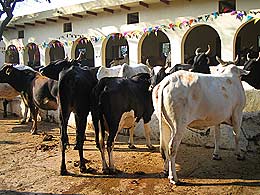 | ISKCON Gosala
is situated just next to it. |
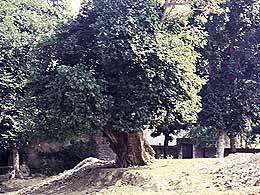 | Further can be seen another interesting tree, called Radha-Krisna tree. Dark Krisna embraces white Radharani... In 90ties there was construction going on at this plot and the tree was to be cut. But fortunately a devotee gave some money to the owner to spare it and let the tree live. |
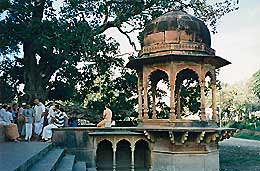 | Still further is a place called Kaliya-hrada. In times of Krisna's pastimes a serpent named Kaliya lived in Yamuna river. Due to poisonous vapor the tree and grass near the bank of the Yamuna had all dried up... |
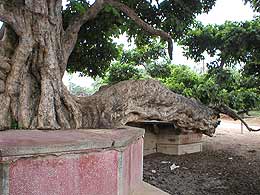 | ...Lord Krisna saw the effect of the great serpent's poison: the whole river that ran before Vrindavan was now deadly. Krisna climbed up in a big Kadamba tree, tightened His belt cloth and flapping His arms just like a wrestler, jumped into the poisonous lake... |
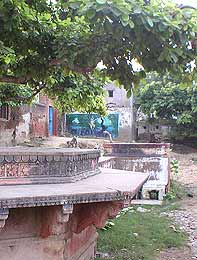 | ...Krisna and Kaliya serpent fought within the Yamuna river. The Lord danced upon Kaliya's hoods and defeated him, but speared his life because of the sincere prayers of the naga-patnis, the serpent's wives. The kadamba tree from which Krisna had jumped was the only tree, which was not dead. Some say that due to touching the lotus feet of the Lord, the tree became immediately alive... |
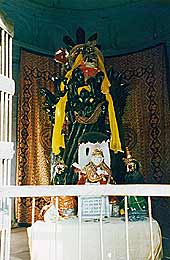 | ...But in some Puranas it is stated that Garuda, the eternal carrier of Visnu, knew that Krisna would take this action in future, so he put some nectar on this tree to preserve it. In either case the same tree is still standing at Kaliya-ghat and nice Deity of Krisna's dancing oh Kaliya's hoods can be seen there. |
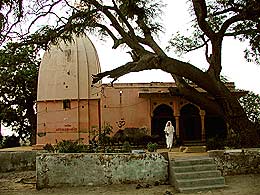 | Nearby Kaliya-mardana Temple... |
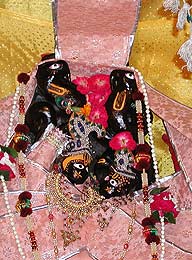 | ...where 5000 years old Deity installed by Vajranabha is worshiped... |
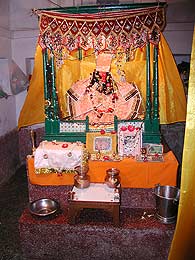 | ...by friendly pujaris. |
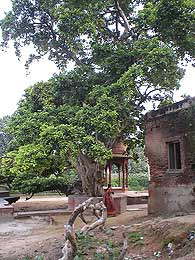 | Beginning in the year 1511, Sri Caitanya Mahaprabhu made a journey of the holy places in South India. On Sukla Ekadasi He arrived at Ranga-ksetra, where He decided to stay and practice austerities during the four months of Caturmasya. At this time Lord Caitanya stayed at the home of three brothers: Tirumala, Vyenkata (whose son was Gopal Bhatta Goswami) and Gopal Guru (Prabhodananda Sarasvati) In his youth Gopal Bhatta was instructed by Prabhodananda Sarasvati... |
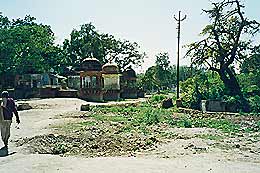 | ...They were Sri Vaisnavas, followers of Ramanujacarya, and devoted to the worship of Laksmi-Narayan. Lord Caitanya explained superiority of Lord Krisna's lila to His hosts, and according to Caitanya-caritamrita (Madhya, 9) they became great devotees of Lord Caitanya after that... |
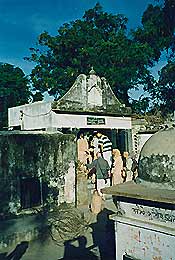 | ...Prabhodananda Sarasvati became follower of Sri Caitanya Mahaprabhu and is considered one of the great acaryas in the gaudiya-vaisnava sampradaya. Actually he is one of the great eternal associates of the Lord. When the Lord appeared in His original form of Sri Krisna, Prabhodananda Sarasvati was one of the important gopis, Tungavidya devi. After Sri Caitanya left South India he meditated about his Lord and left his home at Ranga-ksetra and traveled to Vrindavan, where he stayed in the forest of Kamyavan and where he was soon met by his nephew, Gopal Bhatta Goswami... |
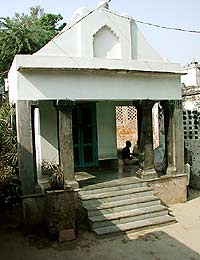 | ...Samadhi tomb of Prabhodananda Sarasvati is located on what was previously the bank of Yamuna river near Kaliya-ghat. |
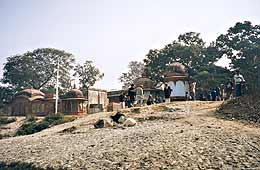 | Prashkananda-ghat, where Krisna's prashkananda (perspiration) caused a small lake to appear is no longer visible as well as Suraj-ghat where Surya performed great austerities so that he could achieve darsan of Lord Krisna. Srimati Radharani also prayed here to Sun god to appear and warm Lord Krisna who felt very cold after spending a long time in the water chastising Kaliya. |
 |
Parikram road used to be beautiful dust sand road where anybody could walk barefoot even when not use to.
|
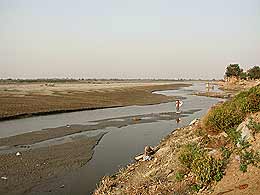 | Walking on the old riverbed bring us to a place where one of the Yamuna branches flows today. |
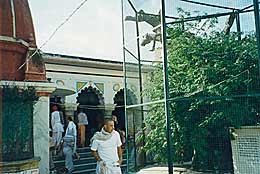 | Imli-tala
"Imli" means "tamarind" and this tamarind tree dates back as far as Lord Krisna's times, five thousands years ago. Krisna would come here on the bank of the Yamuna and because of His ecstatic feelings of separation from Radharani, His blackish body would turn golden... |
 | ...Gauranga Mahaprabhu would also come here and meditate upon Krisna. Due to ecstatic love His golden body would on the contrary turn blackish... |
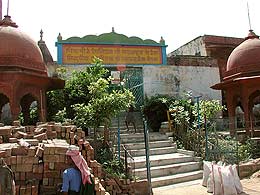 | ...The old tree is said to be cut by neighbors and blood was flowing from the tree instead of sap. Tree dried up, but another tree is growing there from its offshoot. |
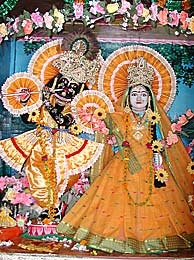 | "I worship the lotus feet of the form of Sri Krisna that manifests when He is thoroughly immersed in separation from Srimati Radharani (who is displaying mana, Her mood of jealous anger), or when He is embraced by Srimati Radhika (after Her mana is broken). At these times, His own dark complexion vanishes and He assumes Her bright, golden luster. I worship the lotus feet of this Sri Krisna."
Bhakti Prajnana Kesava Maharaj |
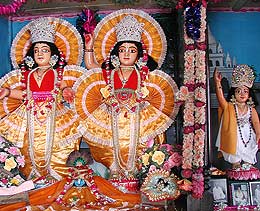 | Beautiful Deities at Imli-tala. |
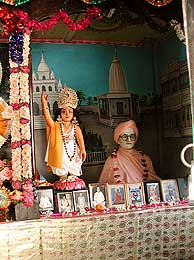 | Gaudiya Math founded by Bhaktisaranga Maharaja (disciple of Bhaktisiddhanta Sarasvati) is present there today. His samadhi is just next to tamarind tree. |
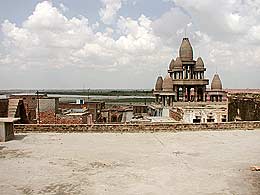 | A new temple is being build for Radha-Govinda (2004) at Imli-tala. |
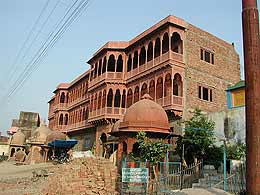 | Next to Imli-tala is Gopinath-bhavan. |
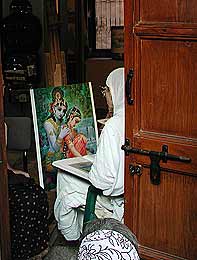 | Jadurani... |
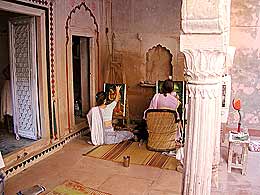 | ...and other artists paint beautiful Krisna-lila paintings at Gopinath-bhavan. |
 | Sri Caitanya Mahaprabhu resided for several days at Akrura-ghat (on the border between Vrindavan and Mathura). Daily He would come to Imli-tala where He chanted harinama immersed in bhava. One day some people requested Him to come to Kaliya-ghat since Lord Krisna is again displaying His pastimes at night... |
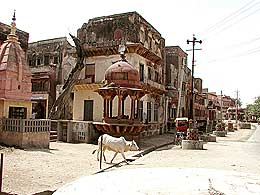 | ...At last it became evident that the spectacle on the Yamuna was nothing more than some Muslims catching fish. "Bhagavan Sri Krisna does not manifest such pastimes before the masses of ordinary people of Kali-yuga. Such pastimes appear only in the hearts of suddha-bhaktas," said Mahaprabhu and some days later He proceeded with Vallabha Bhattacarya to Nilacal. |
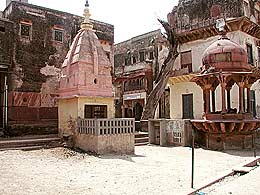 | Sringar-vat (Nityananda-vat)
During rasa-lila, when Srimati Radhika saw Sri Krisna dance with other gopis, She left rasa with mana. Wishing to hide Herself, She sat down in this solitary place... |
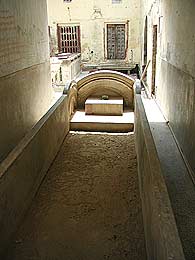 | ...Here Krisna personally decorated Srimatiji with beli, cameli and other flowers... |
 | ...When the other sakhis searched for Krisna, one sakhi said: "Look! Krisna picked flowers here for His beloved, standing on His toes. The ground is marked with only the front portion of His feet!"... |
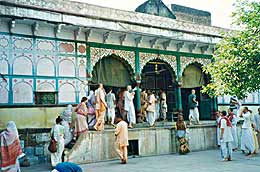 | ...Krisna requested Radharani to quickly leave this place with Him, but She refused, saying She is tired. Krisna than requested Her to sit on His shoulder, but just as She was about to do so, disappeared... |
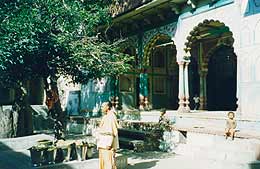 | ...Distressed in separation, Srimati Radharani cried: "O master! My lover! O dearest, where are You? Where are You? Please, mighty armed One! O friend, show Yourself to Me, Your maidservant who is very much aggrieved by Your absence."
Srimad-Bhagavatam 10.30.39 |
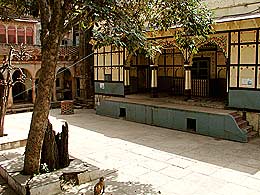 | The original banyan (vat or vata) tree under which the Divine Couple sat has now almost vanished, as it was broken during the flood. A branch from the original tree were found on its way and planted here where it has grown into large tree. |
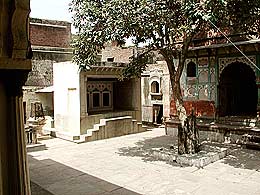 | Nityananda Prabhu, while wandering throughout Braj, stayed near Sringar-vat absorbed in bhava. As avadhuta He was holding neck of cows and asked them: "Where is Kanhaiya? Where is He? One day, He heard a voice from the sky announce: "Your Kanhaiya is waiting for you in Nadia where He appeared as Sacinandana Gaurahari". Sringar-vat is therefore also known as Nityananda-vat. |
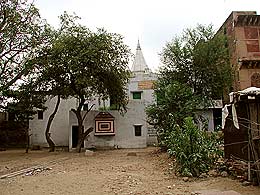 | Jaru-mandala (Jhadu-mandala)
Jaru-mandala means the area (mandala) swept with the broom (jaru) so that devotees could sit down and hear the stories. Once a long time ago an old woman lived here. She made her living by grinding grains on the mortar. Because she was blind, she was doing it sometimes in day, sometime at night, since she could hardly tell what time it was. The gharr-gharr sound disturbed devotees... |
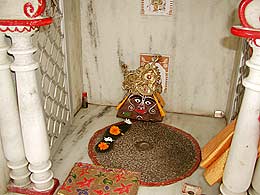 | ...One day as she was grinding during brahma-muhurta, absorbed in singing the sweet names of Krisna, a beautiful dark-complexioned boy appeared and put one foot at her grindstone. "Maiya! Why are you constantly turning the grindstone and making this disturbing sounds?"
"My dear son, if I don't work with the grindstone, then how will I maintain myself?"... |
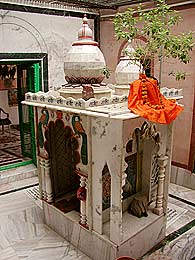 | ..."I will put My footprint on your grindstone. People will come to take the darsan of this footprint and give generous donations."
When she waked up the old lady saw that the boy's footprint had appeared on her grindstone. She was able to maintain herself by donations from visiting people and she always remained intoxicated remembering this lila. It is said that Jaru-mandala is the actual spot where Syamananda received a tilak mark from Srimati Radharani. Old Jamun tree mark this spot today. |
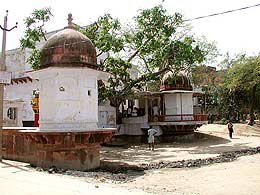 | Govinda-ghat
Here just next to Jaru-mandala Sri Krisna disappeared from Radharani during rasa-lila. |
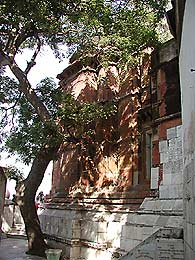 | There is also an old Krisna-Baladev Temple on the opposite side of the road... |
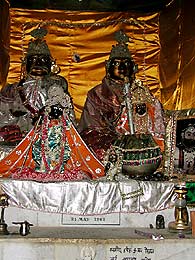 | ...with Nanda, Yasoda, Balaram and Krisna on the altar. |
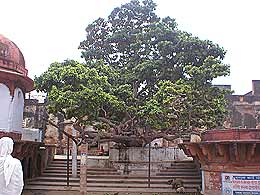 | Cir-ghat (Cira-ghat)
According to Srila Jiva Goswami the actual Cir-ghat is 10 km north of Vrindavan. But there is no harm remembering this intimate pastime in any place. |
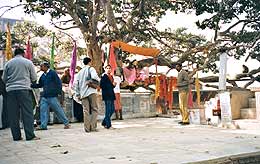 | At Cira-ghat there is ancient kadamba tree (Cir-kadamba). |
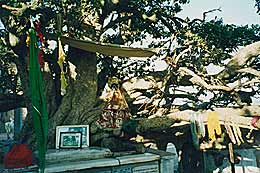 | ...Krisna would climb on this tree and tied gopi's dress on its branches. Pujari keeps remembering this lila until now and one can see Krisna's Deity on the tree and gopi's garments... |
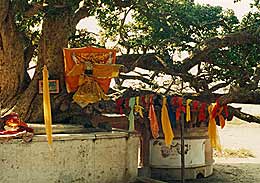 | ...Gopis performed worship of Goddess Katyayani (Katyayani-vrata) to get Krisna as their husband and Katyayani gave them blessing that their desire will soon be fulfilled... |
 | ...Nobody except one's husband can see woman naked. Gopis were taking bath in Yamuna and Krisna stole their garments... |
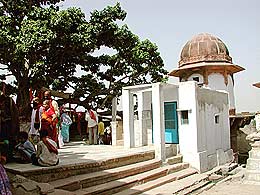 | They wanted them back but He demanded they came out of water and claim them. Since He saw them naked, it was as if gopis became Krisna's wives... |
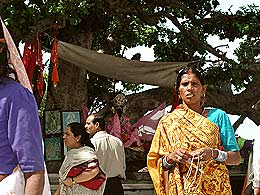 | The Deity of Krisna and gopi's garments on the branches commemorate this pastime today. |
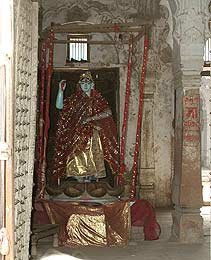 | Yamunadevi
Yamuna Maharani is sri-krsna-svarupini, meaning that she is a manifestation of Visakha. She is bhagavati because she is dear to Krisna and she is krisna because she is blackish in complexion. |
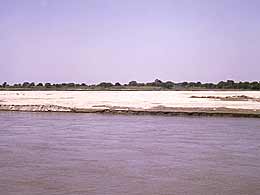 | Yamuna river is the most sacred river in India. The main reason it is so sacred is because it flows through Vrindavan and Mathura, and was thus intimately connected to Lord Krisna's pastimes... |
 | River Yamuna, Govardhan Hill and dust of Vrindavan are three things that remained unchanged from Krisna's Vrindavan to these days. |
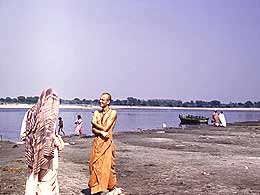 | ...One who bathes in the Yamuna can be purified of all sinful reactions and attain love of Godhead... |
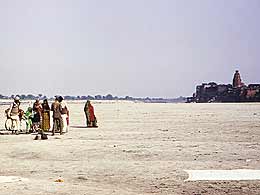 | Yamuna-devi assists the amorous pastimes of Radha-Krisna Yugala (keli-vilas). She flows on three sides of Vrindavan. She creates countless beautiful nikunjas with trees, creepers, flowers and fruits. Radha-Krisna performs jat-keli - water pastimes and nauka-vihara boat pastimes with sakhis. |
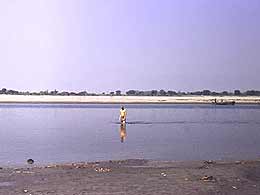 | "I repeatedly offer prayers to Sri Yamuna, the daughter of the Sungod, who is the bestower of unnatojjvala-prema for cidananda-surya-svarupa Nandanandan Sri Krisna. She embodies transcendental bliss and directly personifies the melted form of Parambrahma... |
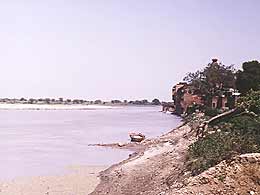 | ...Simply remembering her destroys all types of wickedness and great sins, thus purifying heart. She bestows all auspiciousness upon the world and can bestow braja-rasa into dry, desert-like hearts. May that Yamuna-devi purify us."
Yamuna-pranama, verse 1 |
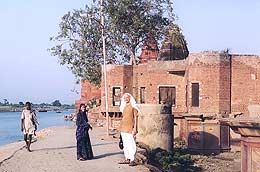 | The Temple tower resembling Madanmohan Temple is abandoned Jugal-Kisor Temple, sometimes called Kesi-ghat Temple, as it is located next to this ghat. |
 | Kesi-ghat
Krisna and His sakhas were grazing the cows there. Madhumangal joked with Him, "Dear Sakha, if You give me Your peacock feather, sweet flute and yellow garments, then all the gopas and gopis will love me and feed me delicious laddus. |
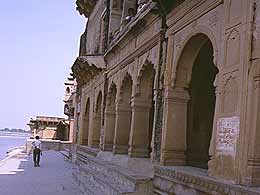 | Nobody will even ask You if you would like some." Smilingly, Krisna personally dressed Madhumangal up in His peacock feather and yellow garments and handed him His flute and staff... |
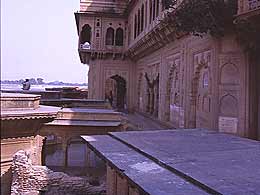 | ...Now all dressed up, Madhumangal began to walk about here and there. Meanwhile Kamsa asked powerful demon Kesi to assume the form of huge horse and told him: "Whomever you see wearing a peacock feather on his head and yellow garments, and holding a flute in his hand, know that person to be Krisna for certain and kill Him." Upon seeing Madhumangal dressed as Krisna, Kesi attacked him with his two hind legs... |
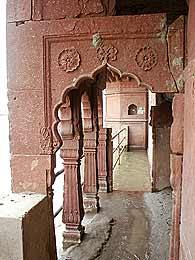 | ...Krisna quickly came to save Madhumangal and killed Kesi demon. Although the demon's legs did not so much as touch Madhumangal, the brahmana boy lost consciousness just by the breeze created by the movement of Kesi's legs. After Krisna killed Kesi, however, Madhumangal became embarrassed. He went to Krisna and handed back His flute, peacock feather and yellow cloth. He told Him, "I don't want any laddus. My life is worth lakhs of laddus." The cowherd boys began to laugh. |
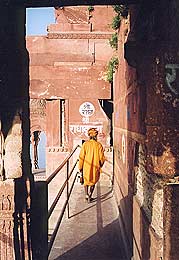 | All devotees and saints performing Vrindavan-parikram had to go through narrow passage on Kesi-ghat. It is really touching to walk on the same places like Bhaktisiddhanta Sarasvati and other Vaisnava sages. |
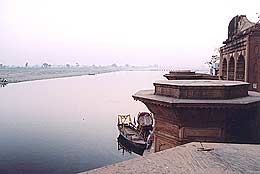 | There is a Yamuna arati performed here every day at sunset. |
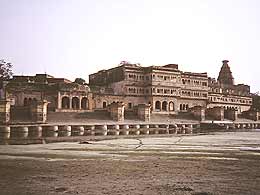 | Riverbed is sometimes full of water, but in other times it may look quite different. |
 | Kesi-ghat from the other bank. |
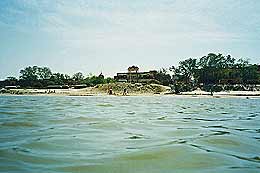 | If you bathe here you get the benediction of bathing in all of the holy places. |
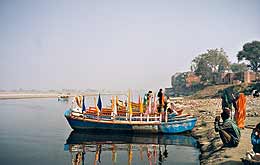 | No bridge is nearby most of the year. One has to take boat to get to other side... |
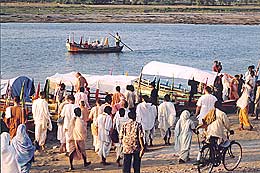 | ...usually with many other people, since than it is cheaper (and more interesting), of course. |
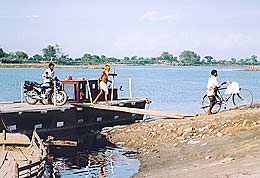 | Pontoon bridge is made usually after the end of rainy season. |
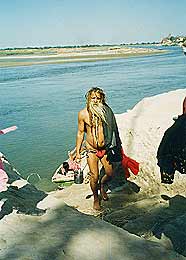 | Located across the Yamuna in a secluded area was asram where Devraha Baba lived in a hut located above the ground. For years Devraha Baba did not touch the ground. His two senior disciples now run the ashram and give classes and speak good English. To get to this ashram, you take a boat across the river at Kesi-ghat and then walk about 20 minutes to the right (south). |
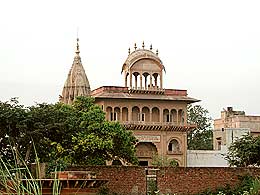 | Tekarirani Temple
was built in 1871 by queen Indrajita Kumari. Her husband was Hitakama Thakur the king of Gaya district in Bihar... |
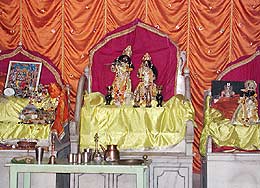 | ...Radha-Krisna, Radha-Gopal and Sri Laddu-Gopal are three Deities in this temple, famous for its hospitality. |
 | Queen Indrajita Kumari donated this temple to Devraha Baba... |
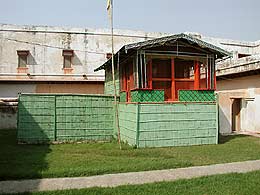 | ...whose bhajan-kutir can be seen in adjacent courtyard. This cottage was formerly in his asram on the other side of Yamuna river. |
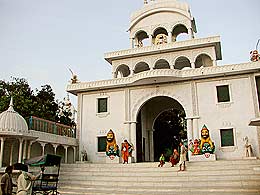 | Jagannath Temple
Haridas, one ramanandi-vaisnava, devoted to Lord Krisna, used to meditate on the bank of Yamuna near Vamsi-vat. In a dream, Lord Jagannath appeared to him and told him his desire to be worshipped in Vrindavan. He told Haridas to go to Jagannath Puri and bring the old Jagannath Deity that was this year to be replaced during rejuvenating ceremony... |
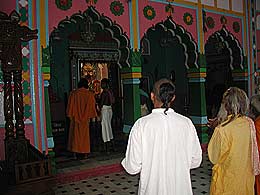 | ...Haridas gathered disciples and with loud sankirtan headed towards Puri. When he arrived, he went straight to main Jagannath Temple and requested pujaris to allow him to take replaced murti back to Vrindavan. The priests refused and send him directly to the king who was in charge of the temple. But even the king refused his request, saying that the murti must be buried to the ground... |
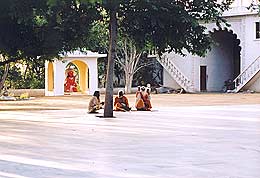 | ...Despaired Haridas decided to stay at the beach and fast until death. That night Jagannath appeared to the king and angrily asked the king why he refused to do what He Himself ordered... |
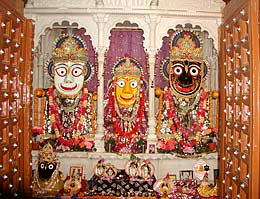 | ...Upon waking the king immediately called for Haridas and granted him the permission to take old Jagannath's Deity back to Vrindavan. Jagannath, Baladev and Subhadra with the contingent of soldiers and priests were on the chariot brought to Vrindavan and installed on the bank of Yamuna at this place, which than became known as Jagannath-ghat. |
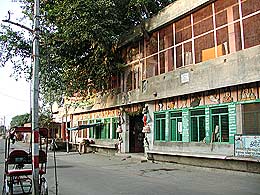 | Caitanya-kuti (Caitanya-kutir)
"If Sriman Gauranga Mahaprabhu had not appeared, then what would have become of us? How could we have tolerated living? In this universe, who would ever have come to know about the glories of Srimati Radharani and the topmost limits of prema-rasa?... |
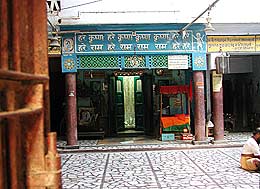 | ...If Sri Caitanya Mahaprabhu had not come, who would have had the intelligence to join the sweet madhura-rasaof Sri Radha-Krisna's lilas in Vrindavan? Who else but Mahaprabhu could have bestowed the power to enter the braja ramani's loving mood of seva to Yugala-Kisor?"
Yadi-Gauranga-Nahito by Narahari das |
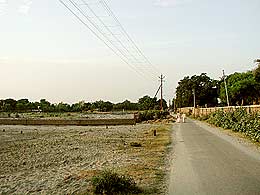 | Pani-ghat
At the time of Krisna's pastimes Maharisi Durvasa had his asram on the opposite side of Yamuna near Pani-gaon. Gopis of Vrindavan wanted to please him by delicious food. Yamuna was in flood due to the monsoon and nobody had the courage to take them to the other side. Suddenly Krisna appeared and smilingly asked them what troubles their mind...
|
 | ...They told him about the flooded river and He replied: "Go to Yamuna and declare 'If Krisna has not seen the face of any woman, than on the strength of his being brahmacari (celibate), we may cross the river on foot.' " The gopis did as Krisna told them and to their surprise, Yamunadevi immediately parted her waters and allowed the gopis to cross on foot... |
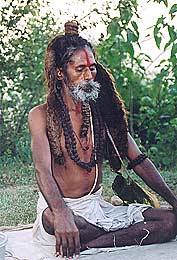 | ...They have satisfied the sage with huge quantities of delicious food. Durvasa Muni blessed all the gopis and gave Radharani special benediction that whatever She cooks will taste like nectar and whoever eats Her food will achieve a long life and will never get sick. This is the reason why Mother Yasoda would ask Radharani to cook daily for her son Sri Krisna... |
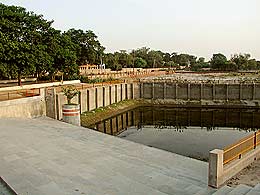 | ...When they were ready to return, Durvasa Muni sensed their worries and told said: "Tell Yamunaji - 'If Durvasa has not eaten any food than on the strength of his austerities, may we cross over your waters.' " And again Yamuna granted them the passage... |
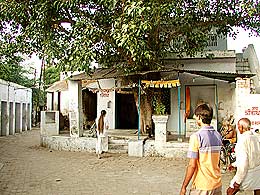 | ...They have inquired Krisna about this mystery and He replied that because I do not possess bhokta-abhimana(identity of being enjoyer) my brahmacarya remains intact even though I am from My birth surrounded by women and stay with you every night. Similarly Durvasa is free from bhokta-abhimana and although he ate everything it was as if he was eaten nothing. |
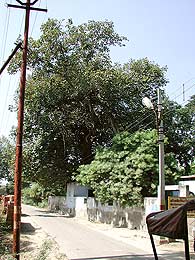 | Passing Adi-badri-ghat where Vyasadev wrote the Tenth Canto of Srimad-Bhagavatam and Raj-ghat where Krisna disguised Himself as a boatman demanded to wash Radharani's feet and than wanted to be fed by all the sweets they were carrying we will approach the old banyan tree at Sri Caitanya-visram-sthali... |
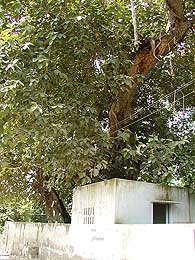 | Lord Caitanya used to sit beneath this banyan tree at Raja-ghat and rest.
|
 | In small kutir, there is a Deity of Sri Caitanya... |
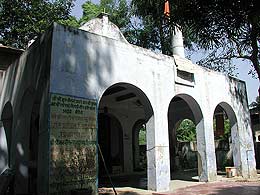 | ...and nearby the temple of Lord Jagannath. |
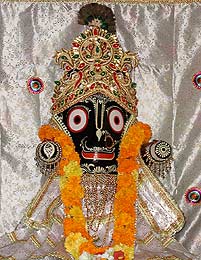 | It is believed that the Jagannath Deity was worshipped by Murari Gupta. |
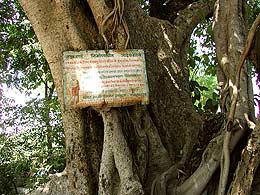 | When Sri Caitanya Mahaprabhu came to Vrindavan via Jhadikhanda path, there was no village, only a deep forest... |
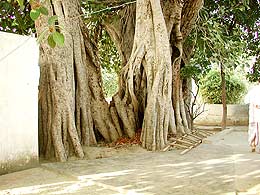 | ... At night, He resided at Akrura-ghat and at down He would sit at Imli-tala on the bank of Yamuna... |
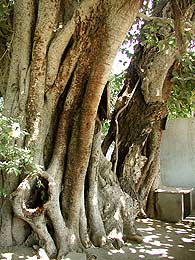 | ...Mahaprabhu would chant harinam until the third praharain afternoon... |
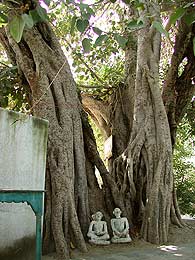 | ...Sri Balabhadra Bhattacarya was the only person with Him at this time. |
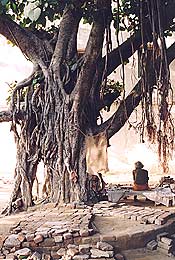 | When we cross the Mathura road and the train tracks passing by this banyan tree we have nearly completed the parikram. |
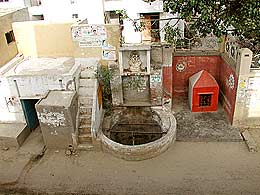 | Radha-kupa
Radharani's well where pilgrims loudly call Radha's name that comes back with echo. |
 | Parikram is completed. By circumambulating the temple of the Lord one becomes feed from innumerable sins. By circumambulating Vrindavan one automatically circumambulate 5000 temples at once. Brijbasis usually go on parikram on Ekadasi. As they say the benefit of circumambulating Vrindavan is much greater. It is believed that offences committed knowingly or unknowingly are washed of by circumambulating Vrindavan. |
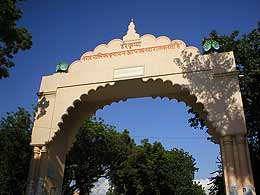 | After Vrindavan-parikram we will go to see other places inside the town area. Bhaktivedanta Swami Gate at the entrance of the town from Cattikara road welcomes you in. |
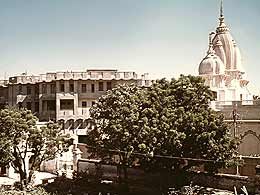 | The first temple to your left is Krisna-Balaram Mandir founded by A.C. Bhaktivedanta Swami Prabhupada.
Separate page with many images from different times about Krisna-Balaram Mandir can be found here. |
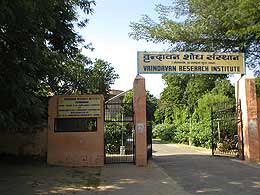 | Vrindavan Research Institute and Library
stores some of the original manuscripts as well as historical documents and records. |
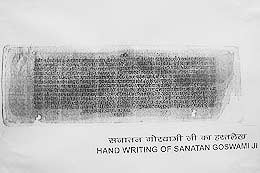 | Handwriting of Sanatan Goswami... |
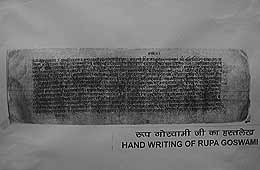 | ...Rupa Goswami... |
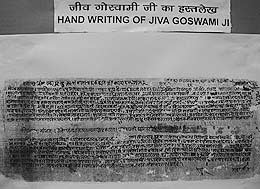 | ...and Jiva Goswami. |
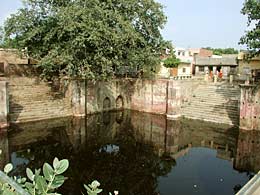 | Davanala-kund
On the day Krisna subdued Kaliya, cowherd boys could not return to their residences at Cattikara as night was approaching and they had moved from the poisoned Kaliya-daha to a sarovara further to the east. The servant of wicked Kansa set surrounding forest ablaze in all directions. Fire was overwhelming and Krisna told everyone to close their eyes... |
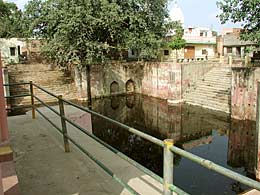 | ...He also closed His eyes and at once swallowed that devastating forest fire as if it were cool water. The sarovara (lake) where this lila took place is called Davana-kund. "Davanala" means "forest fire". |
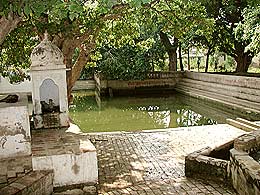 | After extinguishing the forest fire, Sri Krisna rested at nearby Vishram-kund. |
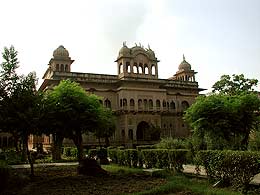 | Jaipur Temple
This temple was built by Maharaj Madhosingh (Sawai-Madhav) from Jaipur. The construction took almost 30 years (opened 1917) and because of the need to transport huge sandstone pieces, Maharaja also sponsored the railway connection from Mathura to Vrindavan. It is the most grandiose and opulent temple in Vrindavan... |
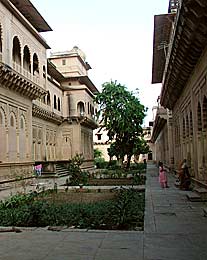 | ...In the northern chamber there is Ananda-Bihari, in the central Sri Radha-Madhava and in southern Sri Nitya-Gopal and Giridhari. Murtis of Narada Muni, Sanaka, Sanatana Sanandana and Sanat Kumaras are also present there. |
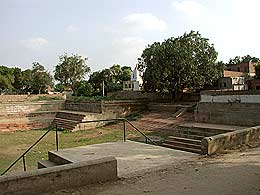 | Govinda-kund
Krisna and Balaram used to rest at the banks of Govinda-kund in the middle of the day. The boys and their cows would drink clear water of this kund. Krisna's sakhas would massage Krisna's and Balaram's feet while They rested... |
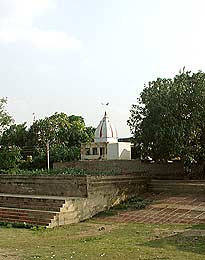 | ...It is the largest kund in Vrindavan and both Rupa and Sanatan stayed here for some time doing bhajans. It is usually dry and fills with water only during rainy season. Ghats were built by Bengal princes Candharani Kali-sundari from east Bengal. |
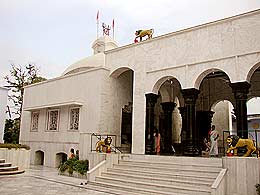 | Katyayani Temple
It is said that here the hair (katya) of Goddess Kali fell from the sky.
Gopis used to make a Deity of Goddess Katyayani from sand on the shore of Yamuna, which is the local tradition during Katyayani-vrata, and worship her to get Krisna as their husband. The actual place where gopis used to worship Katyayani is Tapovan, 10 km north of Vrindavan near Cir-ghat. |
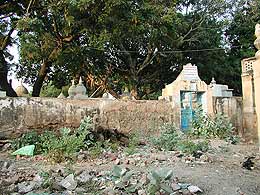 | 64 samadhis
In this garden near famous Govindaji Temple there are full samadhis of Raghunath Bhatta Goswami, Subuddhi Raj and Kasisvar Pandit and 64 samadhis of important followers (Mahants) of Sri Caitanya Mahaprabhu. The three above mentioned Samadhis are full and others are either puspa, nama or smrita samadhis. |
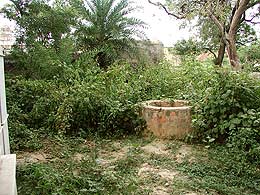 | Venu-kupa
In the corner of this garden used to be a pond. Krisna once dig with his flute (venu) in the ground and created a water spring so that thirsty cowherd boys and cows could drink it. |
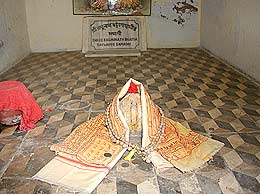 | Samadhi of Raghunath Bhatta Goswami
When Sri Caitanya stayed at Benares in the house of Candrasekhar, Raghunath Bhatta as a small child could serve the Lord by massaging His feet. Later, when Sri Caitanya met him in Puri He was pleased to see him and ordered him to study and remain lifelong brahmacari. Raghunath Bhatta was an expert cook and sometimes he would cook for Sri Caitanya... |
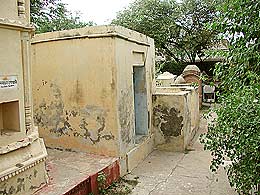 | ...Raghunath Bhatta used to do bhajan in this very same garden and among Vaisnavas was very famous for his wonderful recitation of Srimad-Bhagavatam. He used to sing it in three different ragas (tunes). His fame spread wide and attracted Jaipur king Raj Man Singh to become his disciple. Maharaj not only constructed gorgeous Govindaji Temple but many other temples and ghat's as well... |
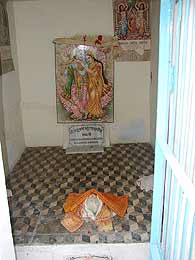 | ...Entombed here are the sacred ashes of Raghunath Bhatta's body. Devotees have decided to cremate his body similarly as Raghunath dasa's because they have feared desecrating by Muslims. Raghunath Bhatta is an incarnation of Raga-manjari, one of the eight intimate maidservants of Srimati Radharani... |
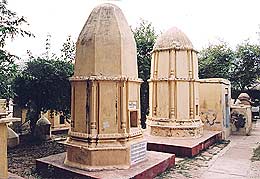 | ...Raghunath Bhatta often recited Bhagavatam in front of Rupa and Sanatan and their samadhis are just next ho his. His personal Bhagavatam can be seen in Bhattaji Mandir near Radha-Vallabha Temple in Vrindavan. Raghunath Bhatta was also known for his aversion towards criticism of Vaisnavas. Even there were right reasons for criticisms, Raghunath was disinclined to hear even that saying that those who are engaged in devotional service will be soon purified. |
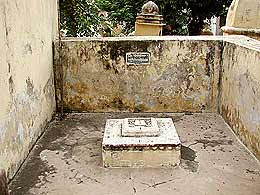 | Samadhi of Kasisvar Pandit
Kasisvar was a disciple of Isvara Puri and as such a godbrother of Sri Caitanya. Isvara Puri sent him to serve Lord Caitanya to Jagannath Puri. Kasisvar was very tall and strong and his service was to pull away crowds in front of Sri Caitanya so that He could proceed further. With his hands he would protect the Lord like a bodyguard. |
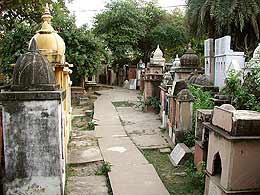 | ...Kasisvar also liked to distribute prasadam to the devotees after kirtans and later Sri Caitanya sent him to Vrindavan to serve Govindaji Deity. He was an incarnation of Bhringara, Lords personal servant. |
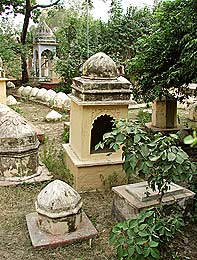 | Samadhi of Subuddhi Raj
Subuddhi Raj was a landlord of Bengal. Once he punished Hussain Khan, a man responsible for construction, by a whip. After some time this man become appointed Nawab of Bengal by Muslim Emperor. His wife once noticed scars on his back and haring that this was due to punishment by Subuddhi Raj demanded his death... |
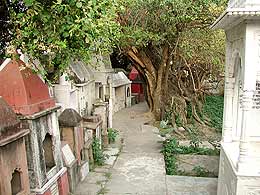 | ...Hussain Khan found this situation very difficult, since Subuddhi Raj raised him from childhood and was almost like a father to him. He decided to sprinkle the water from his water-pot on his head and thus convert him to a Muslim. In those days it was it was sufficient to convert anyone from Hindu to Muslim just by sprinkling water from a Muslim's water-pot and in the eyes of orthodox brahmanas he was socially ostracized... |
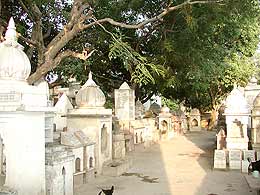 | ...Subuddhi Raj left home and traveled to the holly places. In Benares he was told by local brahmanas to commit suicide. At this time Lord Caitanya was also present there and met Subuddhi Raj. He told him not to commit suicide but to constantly chant holy name instead and go to Vrindavan. Subuddhi Raj spent the rest of his life in Vrindavan and become a close friend of Raghunath Bhatta Goswami. His samadhi is near the samadhi of his dearmost friend, Raghunath Bhatta. |
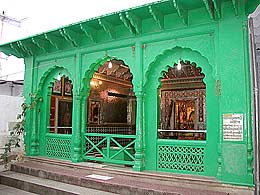 | Temple of Jugal-Kisor is known as Mirror Mandir because the walls are decorated with thousands of small mirrors. In the courtyard of the temple is the Radha-nama Bank, where pilgrims are encouraged to write as many Radha's names as possible on paper, which is deposited in this "bank" for eternal benefit of the writer. |
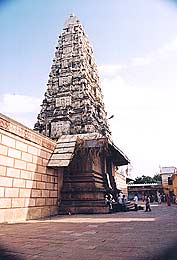 | Lord Ranganath's Temple resembles famous temple in Sri Rangam in Tamil Nadu. Rangaji is a form of Lord Visnu lying on the Sesa Naga. |
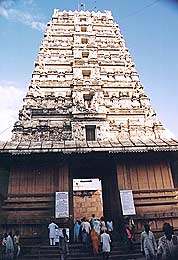 | It is constructed in the South Indian Dravidian style and has an impressive gopuram tower over the main entrance. It is the biggest temple in Vrindavan. It was built in 1851 by Laksmicanda Seha at the expense of 4,5 million rupees. |
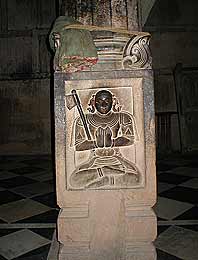 | Until recently Non-Hindus (non-Indians) were not allowed unto the main temple area where the Deity is worshiped. They were allowed only on the courtyard... |
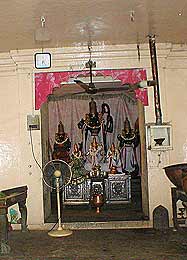 | But in Karttik 2004 we were even allowed to take a picture of the Deity of the Lord. |
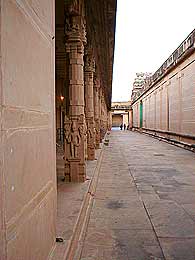 | The temple is surrounded by high walls... |
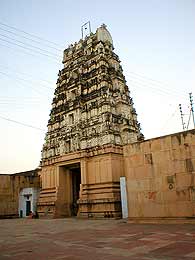 | It has traditional gates... |
 | ...mandapa providing shade for rest... |
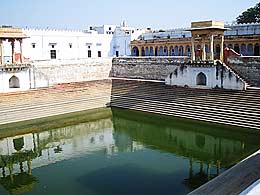 | ...and of course temple-sarovar (lake)... |
 | ...as any temple built in South Indian style should have. |
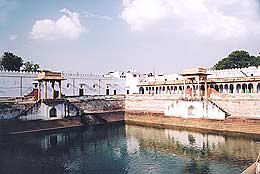 | Near the Western door is a chariot, upon which Sri Rangaji rides on special occasions. |
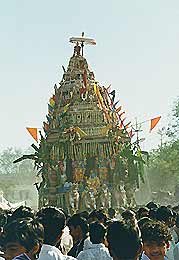 | Once a year a Ratha-yatra for Lord Ranganath is held. The Lord cart is pulled to nearby Rangaji garden. |
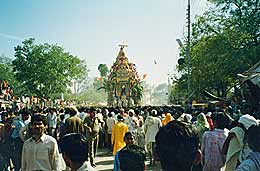 | The carts are smaller than in Puri, but sentiments of devotees can be the same. |
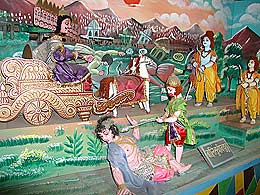 | At the entrance of the Rangaji Mandir are moving dioramas depicting different lilas of the Lord - killing of Ravana... |
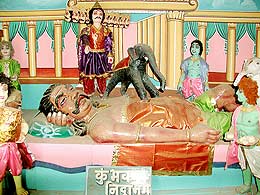 | ...and waking up of Kumbhakarna from Rama-lila. |
 | Rasa-lila... |
 | Govardhan-lila and others from Krisna-lila... |
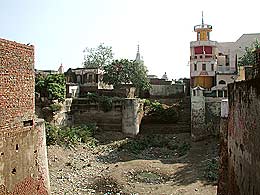 | Brahma-kund
Brahma-kund was originally created by tears of Lord Brahma, when he was regretfully crying after stealing cowherd boys from Krisna. Yogamaya Paurnamasi gave Mahadev Sankara a gopi-form by dipping him in this kund. Vrindadevi also gave Narada the form of Naradi-gopi by bathing him here, thus fulfilling his desire to take darsan of rasa-lila. |
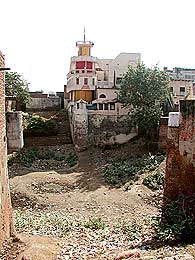 | There is an asoka tree on the northern side of this kund. It blossoms with flowers at exactly noontime on the Visakha-sula Dvadasi. Only extremely fortunate rasika-bhaktas can take darsan of those flowers and no one else, as it is stated in Varaha Purana. Until recently the kund was full of water, but at present it have dried up. |
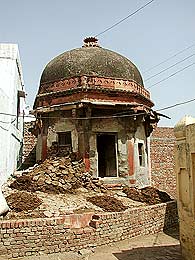 | An ancient temple at the bank of Brahma-kund. |
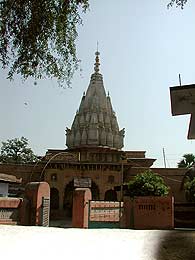 | Lal-Babu Mandir
Lal-Babu was wealthy landlord from East Bengal. He liked to go for walks from his mansion to the other side of the river. One day he heard boatman saying: "Brother! Day is over. Go across!" Those words inspired his thought about his own mortality and in his heart he actually heard: "Life is reaching its close. Quickly cross over this material existence!"... |
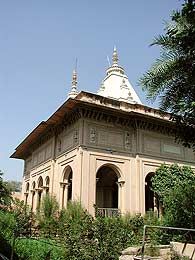 | ...Next day during his walk he heard washerman addressing his wife: "The day is over. Go and burn the vasana!" The bark of banana is called "vasana" in Bengali, but it also means "passion" or "desire". Boatman's words sounded in his head like: "The days of your life is over! Burn your lusty desires!" It made a great impression on him and shortly afterwards abandoned his luxurious living and came to Vrindavan... |
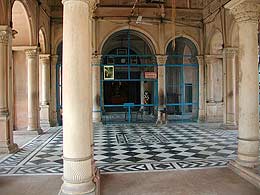 | ...As a young man he become vairagi (renounced saint) and constructed this magnificent stone temple. In 1810 he installed the Deity of Sri Krisnacandra. Lal-Babu also constructed ghats surrounding Radha-kund. |
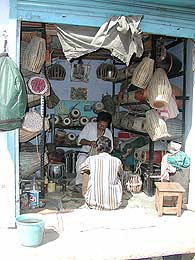 | Pankaj Prabhu in his musical shop near Lal-Babu Mandir. |
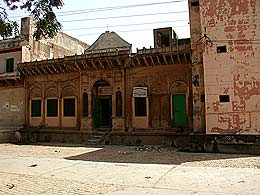 | Braja-Mohan Temple
The Deity of Braj-Mohan was installed by Narottam das Thakur during the Khethuri festival in Bengal. Khethuri festival was the first festival celebrating the appearance of Sri Caitanya Mahaprabhu. It was actually the first Gaura-purnima as we know it today and all the prominent Vaisnavas of those times attended it. |
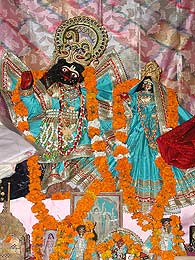 | Srinivas Acarya personally performed abhisek for Braja-Mohan and other five Deities. Out of them only Braja-Mohan was brought to Vrindavan for worship. |
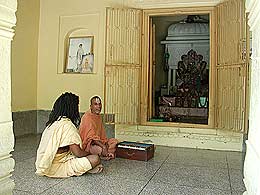 | Devotees and pujaris were very friendly and Narottam's Deities of Braja-Mohan are very sweet. |
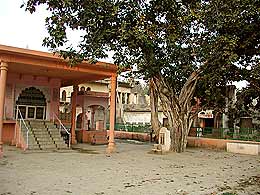 | Jnana-Gudri (Jnana-Gudadi)
Sri Narada once said to Prayag: "Bhagavan has given you the name Tirtharaj - the king of holy places. But I doubt it is true. Does Vrindavan ever come to make an offering to you along with the other tirthas?"
"No," said Prayag.
"Than what kind of Tirtharaj are you?..." |
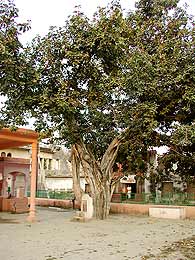 | ...Seeing Tirtharaj approaching, Bhagavan honored him appropriately and ask him why he has come in such sad mood. "My master, You have appointed me as Tirtharaj and all the holy places come to me with their offering, but the tirtha Vrindavan never comes to me. If small tirtha like Vrindavan does not accept my jurisdiction, than why should I have the title of Tirtharaj?"
Bhagavan became silent for a moment, His eyes brimmed with tears as He remembered Braj, cows, sahkas, Nanda and Yasoda, gopis and rasa-vilas. Than He composed Himself and said: "You are truly the king of all tirthas, but I have not made you the king of My own home, Sri Vrindavan." |
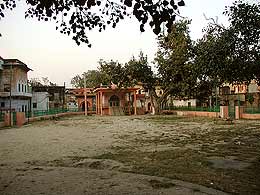 | It is said that Prayag-Raj comes to Vrindavan at Jnana-Gudadi during the flood in the form of black horse. He takes bath here and purified from the sins left on him by the pilgrim his form will change into white horse. Than he returns back. Brijvasis also take bath at this same spot when Yamuna floods during the monsoon. |
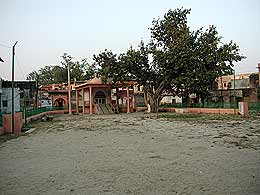 | When Krisna send Uddhava from Mathura to Vrindavan to console Nanda, Yasoda, gopas and gopis, Uddhava delivered His massage. But it was full of tattva-jnana and gopis tore it up so it resembled torn garment (gudadi) and threw it into the water of Yamuna. That jnana-gudadi drifted downstream and fell into the Ganga at Prayag. From there it floated to the salt ocean. The place where the gopis abandoned that message filled with tattva-jnana, leaving it float down the Yamuna like a torn garment is known as Jnana-Gudadi. |
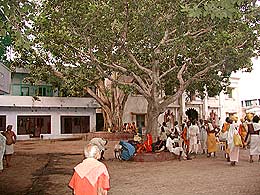 | Sudama-kutir |
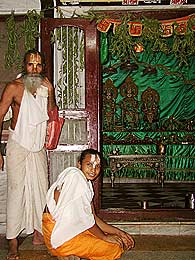 | Priests... |
 | ...and Deities at Sudama-kutir |
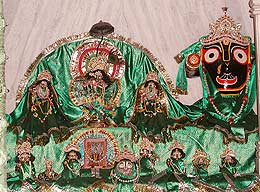 | Radha-kanta Temple
Radha-kanta are Deities of Gopal-guru Goswami. Gopal-guru was a disciple of Vakresvar Pandit, one of the associates of Caitanya Mahaprabhu. As a child Gopal used to meet Sri Caitanya. Once Sri Caitanya jokingly called him a "guru". The name stuck and he became known as Gopal-guru. He studied sastras under Svarup Damodar and Raghunath das Goswami... |
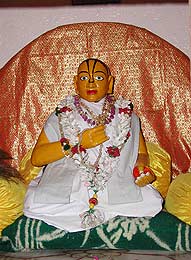 | ...In his last days he became so distressed with separation from Krisna that in the eyes of ordinary people he left his material body. His learned disciple Dhyanacanda Goswami at this time encountered some problems in Jagannath Puri with the government officials regarding bhajan-kutir of Haridas Thakur and Radha-kanta Temple. A vaisnava from Vrindavan told him, that he had seen his guru at Dhira-samira in Vrindavan... |
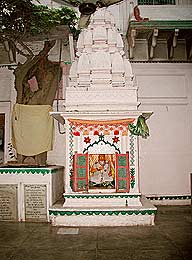 | ...Dhyanacanda Goswami reached Vrindavan in few days and he saw Gopal-guru with nama-mala in his hands and in tears with his eyes as he was remembering various pastimes of the Lord. Dhyanacanda fell at his feet and began to cry. He begged him to return to Puri. Gopal-guru refused, but told him to return without fear. "The disturbance will soon end." By his order, Dhyanacanda returned to Puri and government officials apologized to him. The disciples of Gopal-guru constructed another samadhi of their spiritual master under the same tree where they saw him in his spiritual body talking to Dhyanacanda. |
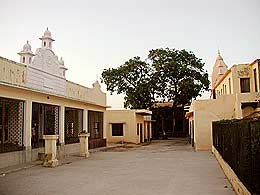 | Dhira-samira
The place on the bank of Yamuna near Vamsi-vat is called Dhira-samira because the breeze (samira) would became so gentle and calm dhira upon having darsan of wonderful keli-vilas pastimes In fact he was so stunned upon seeing them that he was not able to move on and practically stopped. Therefore this place is known as dhira-samira. Gauridas Pandit established a kunja and temple at Dhira-samira and began the puja of Sri Syamaray. |
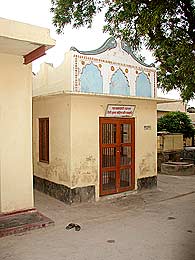 | Samadhi of Gauridas Pandit
Entombed here is the sacred body of Gauridas Pandit, disciple of Lord Nityananda. Gauridas lived in Ambika-kalna near Santipur. His brother's daughters Jahnava and Vasudha were married to Lord Nityananda. When Sri Caitanya accepted sannyas order, He went to Gauridas to say goodbye. Gauridas was so distressed with the prospect of separation that Sri Caitanya had manifest with Lord Nityananda as a Gaura-Nitai Deity and told him that He never leaves his house, staying here in the form of Deity. But Gauridas didn't allow Caitanya to leave... |
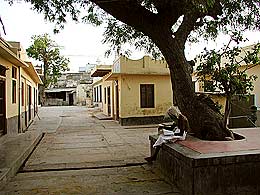 | ...Lord Caitanya with Nityananda posed Themselves as Deities and Deities started to leave. Gauridas stopped the Deities and They stood again in Their Deity pose. Meanwhile Caitanya and Nityananda began to leave. It happened so many times that Gauridas was unable to say which are the Deities and which are the actual Gaura-Nitai and Lord Caitanya could finally leave... |
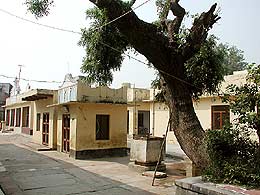 | ...Once during a Gaura-purnima festival Deities of Gauridas Pandit jumped from the altar and joined the devotees in sankirtan. Gauridas started to worry that They may again wanted to leave and started to chase them in angry mood with a stick, calling Them back to the altar. Seeing Gauridas, Deities jumped into the heart of Caitanya das and disappeared there. Gauridasa's disciple was from that day called Hridaya-caitanya, because Caitanya and Nityananda hide inside his hridaya (heart). |
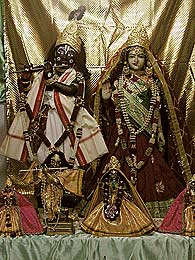 | Radha-Syamaray Temple
Gauridas Pandit performed his bhajan here at Dhira samira and worshipped his beloved Deity of Radha-Syamaray. |
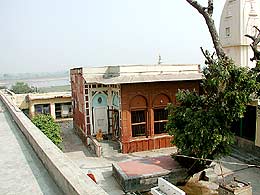 | ...Jayadev Goswami mentions this kunj in Gita-govinda - dhira-samire yamuna-tire vasati vane vana-mali.... - The keli-vat under which Radha and Krisna performed this pastime is situated in Dhira-samira. |
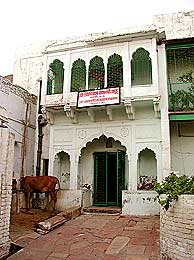 | Srinivas-acarya kunj
When the father of Srinivas-acarya met Sri Caitanya Mahaprabhu at his sannyas ceremony, Sri Caitanya predicted that soon a son named Srinivas would be born to him. In his youth Srinivas became brilliant student and his golden complexion resembled Sri Caitanya. He wanted to meet Sri Caitanya in Puri, but on the way news about Sri Caitanya's departure from this world struck him into grief. He studied Srimad-Bhagavatam from Gadadhar Pandit in Puri and later went to Vrindavan. He become disciple of Gopal Bhatta Goswami and studied sastras under Jiva Goswami... |
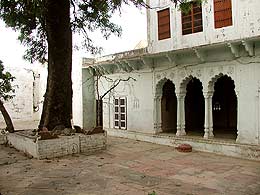 | ...After completing their studies, Jiva Goswami ordered Srinivas, Narottam and Syamananda to take the books of Goswamis and go to Bengal to preach. They set up on the way with bullock cart full of books. Near Vana-Visnupur they entered the kingdom of king Birhambir. He used to consult astrologer about the caravans and rob the merchants. When the first sankirtan party approached his border, the astrologer informed the king that this cart carries an inconceivable treasure. As usually, king's people took the cart, but found only books... |
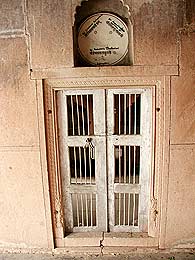 | ...Narottam and Syamananda continued to preach in Bengal, Orissa, Assam and Manipur and Syamananda stayed to reclaim the books. In his search he visited the court of king Birhambir and heard some brahmin explaining Srimad-Bhagavatam. He pointed out his mistakes during recitation and the brahmin asked him if he knows any better. Srinivas started to explain the Bhagavatam as he had learned from Goswamis and everybody included the king told him that they have never heard so beautiful explanation of Bhagavatam. King Birhambir finally become his disciple, returned the books and turned his whole kingdom into Vaisnava state... |
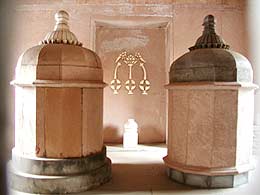 | Samadhi of Srinivas-acarya
Entombed here is a sacred body of Srinivas Acarya. He was and incarnation of Mani-manjari, one of the intimate maidservants of Srimati Radharani, and embodiment of Goura-sakti, spiritual energy of Sri Caitanya Mahaprabhu. He was also a famous poet and his Sad-goswami-astaka is singed by devotees until today. Srinivas, Narottam and Syamananda were most prominent acaryas in the generation immediately following Sri Caitanya Mahaprabhu. |
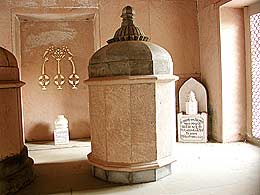 | Samadhi of Ramacandra Kaviraj and puspa-samadhi of Hemlata Thakurani
Ramacandra Kaviraj was disciple of Srinivas-acarya and a friend of Narottam das Thakur. He received a title "Kaviraj" for his wonderful poetry describing pastimes of Sri Krisna and Sri Caitanya. Narottam in one of his bhajans sings ramacandra-sanga mage narottama-dasa "I always pray to be in the company of such a devotee as Ramacandra Kaviraj." Hemlata Thakurani was a daughter of Srinivas-acarya and great preacher of gaudiya-vaisnava philosophy. |
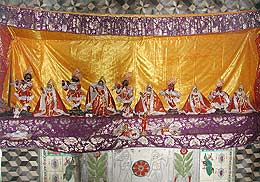 | Inside Srinivas-acarya kunj there is a Radha-madhava Temple. Among the Deities on the bottom shelf is a Jula-Thakur, a personal Deity of Srinivas Thakur who used to carry Him in his bead bag. |
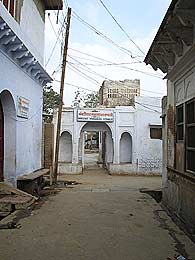 | Vamsivat
On the beautiful full moon night of the sarat season, Krisna started to play a sweet tune on His flute (vamsi) and call gopis. They stopped everything and run toward they beloved in the midst of night. "When the young woman of Vrindavan heard Krisna's flute song, which arose their romantic feelings, their minds were captivated. They wanted to go where their lover waited. Each unknown to others, moving quickly and their earrings swung back and forth." (Srimad-Bhagavatam 10.29.4)... |
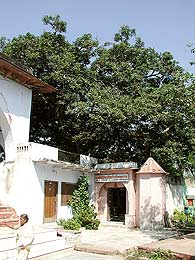 | ...Krisna began to convince them to return home to their husbands, but gopis refuted His arguments. Finally rasa-lila started and gopis felt satisfaction and possibly some pride because of their good fortune. One Krisna was dancing between two gopis and one gopi was dancing between two Krisnas... |
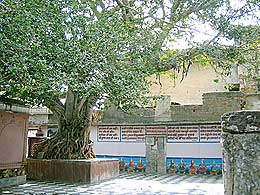 | ...At this moment Krisna disappeared and their pride was transformed into transcendental separation so intense that it was reaching the point of madness... |
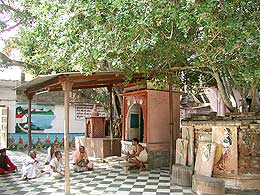 | ...Hearing their despaired singing, Sri Krisna again appeared... |
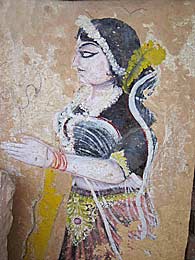 | ...You have performed an extraordinary deed - you have given up everything for Me. For this sacrifice, I am eternally indebted to you and can never repay you."
Srimad-Bhagavatam 10.32.22 |
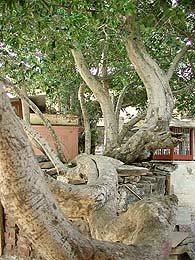 | In this way the divine pastimes of Krisna and gopis continued on Vamsivat, the crest-jewel among lila-sthalis... |
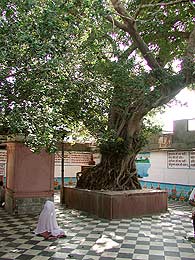 | Sri Vajranabha planted here a banyan tree (vat) in remembrance of these pastimes, but about 500 years ago Yamuna flooded the place and took this tree with her. Sri Madhu Pandit, a disciple of Gadadhar Pandit, took one of its branches, brought it back and planted it here... |
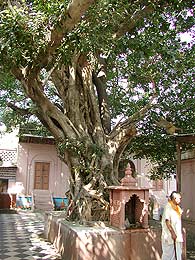 | ...The branch transformed into this vast tree and stands it until today. While planting the tree, Madhu Pandit discovered the Deity of Gopinath here at Vamsivat. |
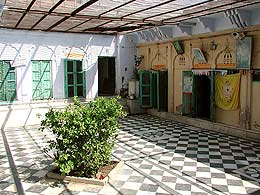 | Gaudiya-vaisnavas use to do seva here, but then Brahmacariji, the guru of the King of Gvalior, bought this place. Since than, it has been under the Nimbarka-sampradaya. |
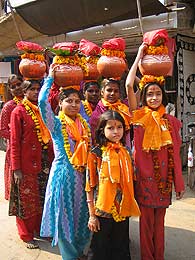 | Vamsivat is a famous place mentioned in innumerable songs. |
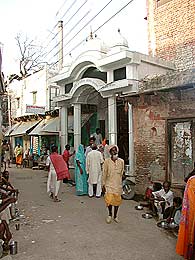 | Gopisvar-mahadev.
Mahadev Sankara once desired to take darsan of Krisna's rasa-lila with his own eyes. Being very eager he came from Kalilas to Vrindavan, but at the gate of Vrindavan, attendant gopis stopped him, because no male except Sri Krisna can enter rasa. Sankara as usually didn't give up easily. He inquired how he might be admitted. Gopis told him to worship Paurnamasi (Purnima).
Sankara worshiped her and Purnima, knowing his desire, dipped him into the nearby Brahma-kund. When he came out of the water, he had been transformed into a beautiful young gopi... |
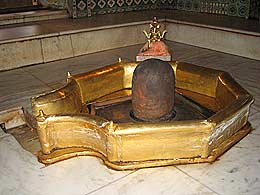 | ...Purnima seated Mahadev, now gopi, inside the kunja of rasa-sthali and disappeared. After a short while rasa-lila began, but the gopis had a strange feelings: "For some reason, we do not feel any happiness today!" They have understood that some outsider had entered the place and began to search... |
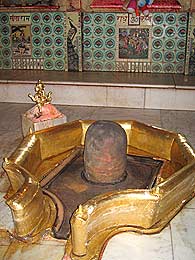 | ...After a while they saw this unknown gopi sitting in this kunj and they began to question her: "What is your name?"
"What village are you from?"
"Who is your husband?"
"Who is your father-in-law?"... |
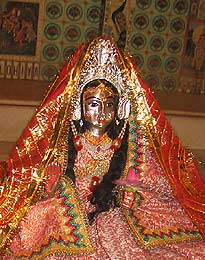 | ...But the gopi was unable to answer any of those questions and began to cry. Yogamaya had neither arranged her birth from the womb of the gopi, nor given her any name. She was not married to any gopa either, so what answers she could give? Gopis receiving no answer began to slap her cheeks until they became swollen... |
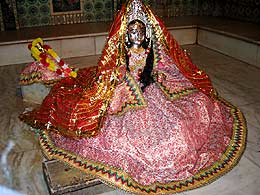 | ...Seeing Mahadev's misery, Purnima's heart melted. She went there and explained that this gopi was an object of her mercy. She requested the gopis and Krisna to be merciful to her. Sri Krisna, knowing the desire of Purnima, gave Sankara the name Gopisvar and granted him a boon that a sadhaka would be unable to enter Vrindavan and especially places of Krisna's sweet pastimes, without the blessing of Mahadev. |
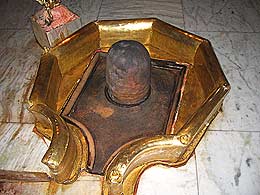 | Vajranabha, the great grandson of Krisna, installed the Siva-linga in this temple. It is said that the big pipal tree here is
a kalpa-vriksa tree and will fulfill all desires. |
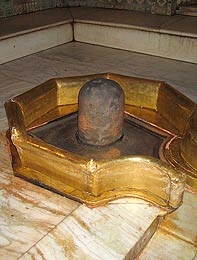 | ."O gatekeeper of Vrindavan! O soma, all glories to you! O you whose forehead is decorated with the moon and who is worshipable for the sages headed by Sanaka, Sanandana, Sanatana and Narada! O Gopisvar! Desiring that you bestow upon me the prema for the lotus feet of Sri-Sri Radha-Madhava, who perform joyous pastimes in braja-dham, I offer pranamas unto you again and again!"
Sankalpa Kalpadruma, 103
by Visvanath-Cakravarti Thakur |
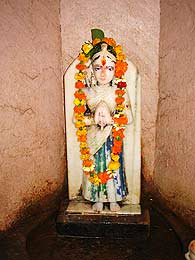 | Gopisvar Mahadev from Vamsivat |
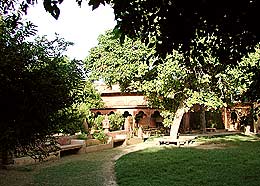 | Vrindakunj
is a beautiful garden in care of Paramadvaiti's disciples. |
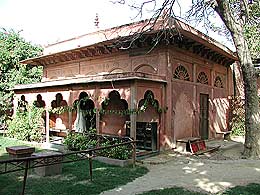 | Simple architecture inspires an authentic feeling of the original beauty of Vrindavan. |
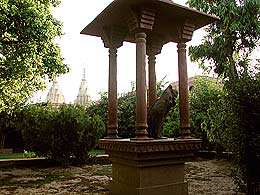 | Vrindakunj is near Lal-babu Temple... |
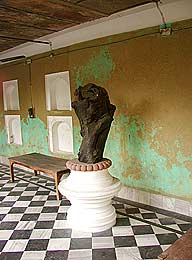 | ...and in the courtyard one can see the broken piece of the original tamarind tree from Imli-tala. |
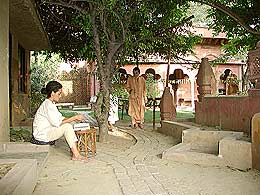 | Gopini stopped her studies for a while... |
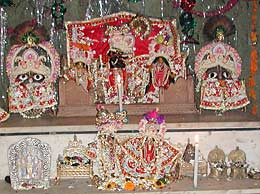 | ...and explained to us that two large govardhan-silas on the altar are "Giridhari" and "Giriraj". One is the Bhagavan Himself - Giri-dhari - "The lifter of Govardhan" and the other is Giri-raj - the king of the mountains and the servant of the Lord. |
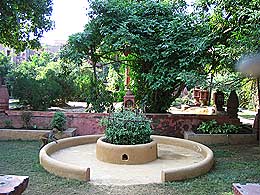 | Of course, nicely kept tulasi plants, cannot be absent in Vrindakunj. |
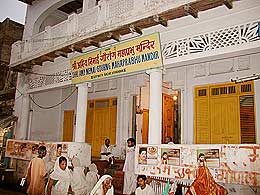 | Amiya Nimai
Amiya means "ambrosia" or "immortal"... |
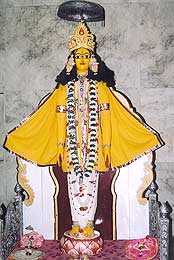 | ...and this tall Deity of Sri Caitanya Mahaprabhu is well known throughout Vrindavan as Amiya Nimai. This Deity as installed by priests from Radharaman Temple. |
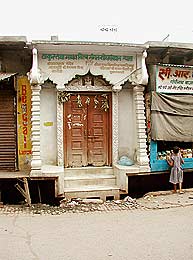 | Samadhi of Bilvamangal Thakur
Bilvamangal Thakur was the most prominent disciple of Visnu Swami from South India... |
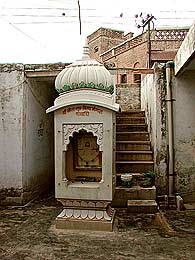 | ...He was a famous poet and the author of Krisna-karnamrita, which was read with delight by Sri Caitanya Mahaprabhu Himself. In his bhajans, he is sometimes mentioned by another name as Lila-sukha. |
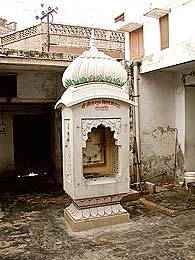 | ...He performed his bhajan in this area about 700 years ago. His sacred body is entombed in this samadhi. |
 | Opposite the gate to the Gopinath Mandir at the same street, there is a temple of Gaura-Nitai called Sona-Gauranga... |
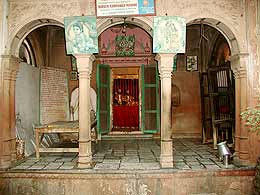 | Sona-Gauranga Temple
Sona-Gauranga Deities were worshipped by Jagannath das Babaji when he was staying at Surya-kund. After his departure for Bengal, they were looked after by a local brahmana... |
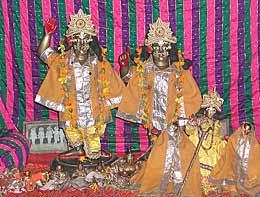 | ...Thieves once thought that these Deities are from pure gold (sona) and wanted to steal Them. Therefore Sona-Gauranga Deities were moved to Vrindavan... |
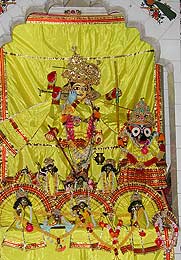 | Sad-bhuj Temple
...When Jagannath das Babaji again returned from Bengal, he began to feel separation from his Gauranga Deities... |
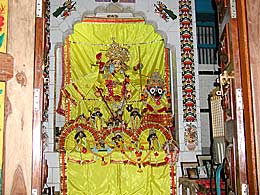 | ...He therefore asked his disciple to find for him another Deity of Lord Gauranga. The disciple just happened to meet a farmer who received a supply of wheat bran for feeding the cows. As the cows began to eat it, beautiful Deity of Sad-bhuj emerged. The farmer gave the Deity to Jagannath das Babaji and when he again returned to Bengal, the Deity was moved to this temple next to Nidhivan. |
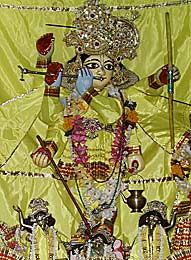 | Sad-bhuj has six arms. Upper hands are Rama's, holding bow and arrow, middle hands are Krisnas, holding flute, and the lower ones are hands of Sri Caitanya Mahaprabhu, holding kamandalu (waterpot) and danda (stuff) of a sannyasi. |
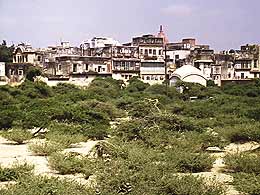 | Nidhivan (Nidhuvan)
Radha and Krisna are said to take rest here after dancing and other conjugal affairs. "Nidhi" means sleep and "van" means "forest"... |
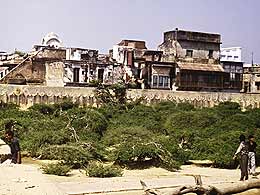 | ...According to others "nidhu" means "surata-krida" or "amorous pastimes" and the whole forest is called Nidhuvan. It is a place where pastime of sleeping and resting at the end of night takes place... |
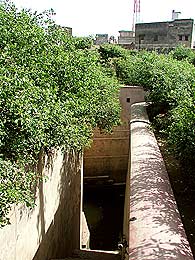 | Visakha-kund lies in Nidhivan, similarly as Lalita-kund lies at Seva-kunj. Krisna created this kund with His flute to relieve thirst of His priya-sakhi Visakha and other gopis. Swami Haridas found a Deity of Sri Banki-bihari here in Visakha-kund... |
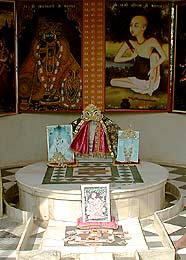 | ...and the shrine commemorating His appearance (Banki-bihari Yoga-pith) is just next to it. |
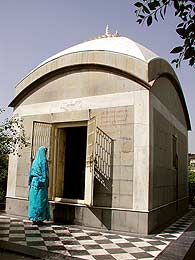 | Just next to a place where Haridas Swami discovered Banki-bihari Deity, there is a small temple called Rang-mahal which has a bed where Radha and Krisna are taking rest... |
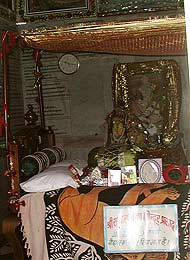 | ...It is also here that Krisna decorates Radharani with various kinds of cosmetics before rasa dance. |
 | There is another small temple dedicated to Radharani... |
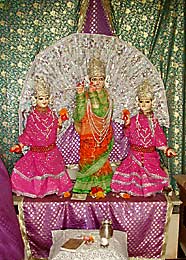 | ...Once She stole Krisna's flute and started to play on it accompanied by Lalita and Visakha. |
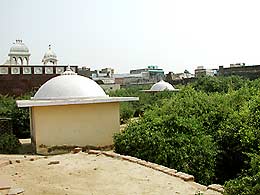 | The samadhi of Haridas Swami is to the left from this central temple behind a small shrine where Radha plays a flute... |
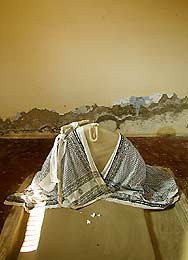 | ...Swami Haridas used to please Sri Bihariji by sweetly singing devotional songs he had personally composed and played vina... |
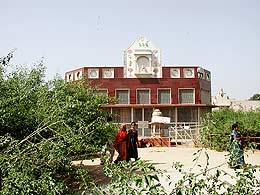 | ...Tanasen and Baijubar were his famous disciples. When Maharaj Akbar heard from Tanasen, who was his minister, about the Haridas, he desired to hear his singing... |
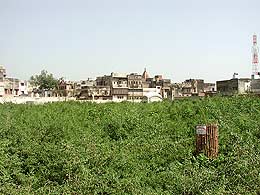 | ...But Haridas had firmly resolved not to entertain anybody but His Bankibihariji. Emperor Akbar therefore resolved to disguise himself as an ordinary man and along with Tanasen went to his kuti at Nidhivan... |
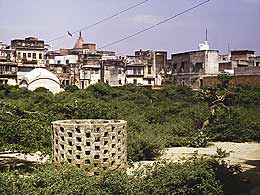 | ...Tanasen, being a good musician himself, purposely brought his vina with him and began to sing in front of Haridas... |
 | ...After a while Haridas took a vina from the hands of his disciple and began to sing the same song, pointing out his mistakes... |
 | ...His singing was so sweet that even the deer, birds and other animals in the forest were attracted to come and silently listen... |
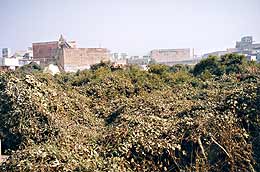 | ...Akbar's amazement knew no bounds. He was so pleased that he immediately wanted to present something for Swami Haridas, but the wise Tanasen advised him not to do so, since it would disturb Haridasa's devotional mood. |
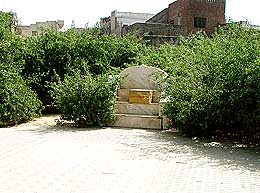 | In Nidhivan, Srimati Radhika sat on the royal throne in a kunj. Sri Krisna, dressed as a police officer, protected the entrance and guarded the area within it. This is called rai-raja-lila and Vaisnava poets sing about it in their songs. |
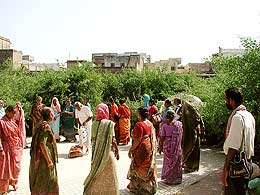 | Because of keli-vilas during the night (nisa) take place at the keli-kunjas at Nidhivan, the sayana-vilas or pastimes of sleeping at the end of the night (nisanta) also take place here... |
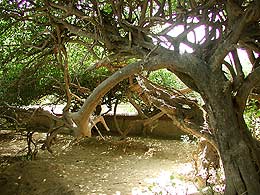 | ...Seeing dawn approaching, Vrinda-devi becomes alarmed and orders the suka, sari, peacocks, cuckoos, bumblebees and others to make their sweet humming and other sounds to wake up Kisor and Kisori. |
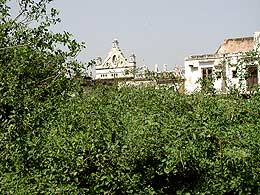 | ...Once when Radha-Krisna Yugala were sleeping in keli-kunj of Nidhivan at the end of the night, Sri Vrisabhanu-nandini had the amazing dream. Upon waking, She woke Her Prana-vallabha and said: "Priyatama, I just had an amazing dream. In that dream I saw a river just like Yamuna. Along that river I saw beautiful bank resembling kunj near Yamuna in Vrindavan. On that bank I saw a wonderful golden-complexioned young man singing and dancing very beautifully... |
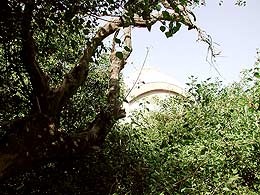 | ...Being absorbed in an internal mood, He was carried away in the dancing to the rhythm of the mridangas and kartalas. That gaura-kisor was crying: "Ha Krisna! Ha Krisna! and sometimes Ha Radhe! Ha Radhe! Where are You! Who is this golden-complexioned youth? Am I this gaura-kisor who is constantly crying Ha Krisna? Or is it You, My Prana-priyatama?"... |
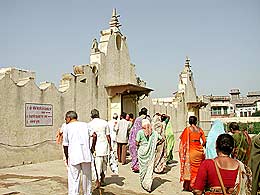 | ..."He Priyatame! At different times I have given You the darsan of Narayan and other My forms, but You were never astonished. Who is this golden-complexioned youth, bewildering Your mind, I cannot say," said Krisna and began to smile. Radhika replied: "Prana-vallabha! Now I understand that this golden form is no other than You! No other is able to infatuate Me in this way!"
Sri Visvanath Cakravarti, Svapna-vilas |
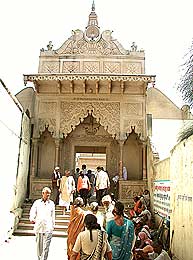 | Entrance gate of Nidhivan. |
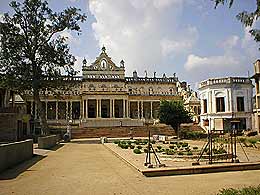 | Shahaji Mandir
was built by wealthy jeweler Shah-kundan Lal from Lucknow in 1835... |
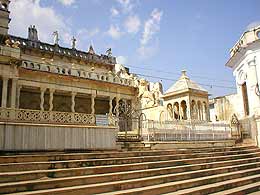 | ...He was a disciple of one of the gosanis of Radharaman Temple and this temple was built for the Radharaman Deity... |
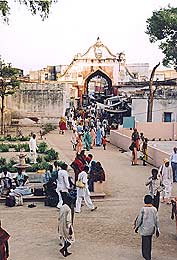 | ...But the gosanis in the last moment decided not to move Radharaman from the old temple where it stayed for centuries and Chota-radharaman ("small Radharaman") was installed instead. |
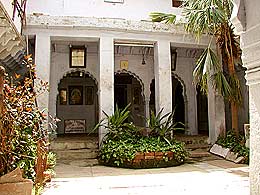 | Mira-bai Temple
Female saint Mira-bhai renounced the life of a princess and come to live in Vrindavan in this place. She is famous for her devotional songs... |
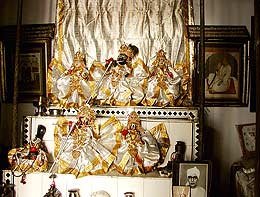 | ...It is said that she encountered many problems and a plot was made to kill her by a snake. But by Krisna's mercy, poisonous snake have turned in front of Mira-bhai into a stone and she was saved... |
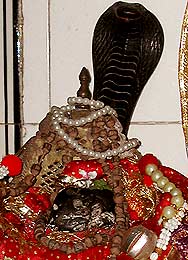 | ...This sila (stone) is kept to the left on the altar. |
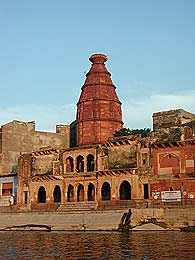 | Jugal-kisor Temple
When emperor Akhbar visited Vrindavan in 1570, he gave permission to built four temples by the Gaudiya-vaisnavas: Madanmohan, Govindaji, Gopinath and Jugal-kisor. It stands next to Kesi-ghat and therefore it is sometimes called Kesi-ghat Temple. |
 | Although it is one of the oldest temples of Vrindavan it was completely abandoned after desecration by Aurangzeb's soldiers in 1670... |
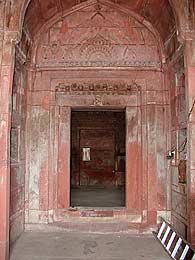 | ...and no pratibhu-murti worship was conducted. |
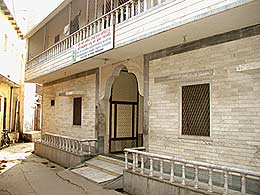 | Gadadhar-dant Samadhi
Gadadhar Pandit was born one year later than Sri Caitanya Mahaprabhu. He attended the same school as Lord Gauranga, lived close to each other and he grew almost inseparable from Him. When Sri Caitanya performed His Navadvip-lila, Gadadhar Pandit was His chief assistant and another name of Sri Caitanya is Gadadhar-prananath, the life and soul of Gadadhar... |
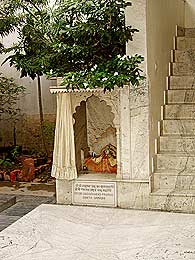 | ...When Lord Caitanya accepted sannyas and went to Jagannath Puri, Gadadhar also accepted sannyas and followed Him. Gadadhar worshipped a Tota-Gopinath Deity and Sri Caitanya told him to become ksetra-sannyasiand never leave Jagannath Puri. When Sri Caitanya ended His prakata pastimes He entered and disappeared into Tota-Gopinath Deity of Gadadhar Pandit. Gadadhar was in incarnation of Srimati-Radharani, but being a ksetra-sannyasi on the request of the Lord never visited Vrindavan. His disciple Nayanananda brought a tooth (dant) of Gadadhar Pandit and entombed it here in this Gadadhar Pandit dant-samadhi. |
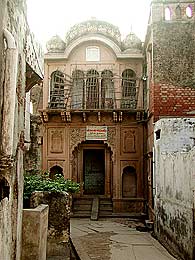 | Vamsi-Gopal Temple
From 1956 to 1959 Srila Prabhupada stayed in this temple when he came as vanaprastha to Vrindavan. |
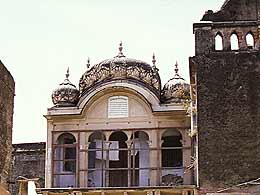 | He lived in a room on the second floor before he had moved to Radha-Damodar Temple. |
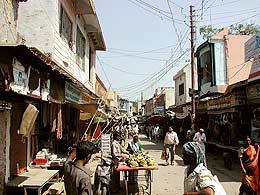 | Loi Bazaar is Vrindavan's most busy marketplace... |
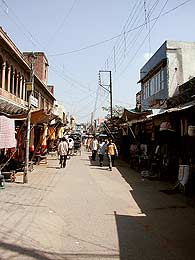 | ...Here you will buy everything necessary from clothes to puja plates for worship... |
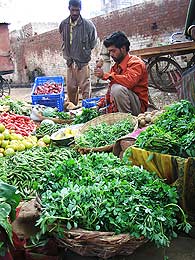 | ...as well as vegetables and fruits... |
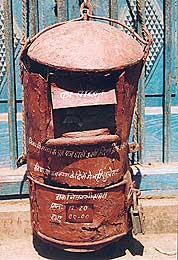 | ...and find a post office with this stylish post box. |
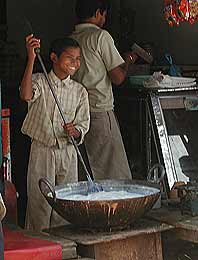 | Sweatshop sellers are usually whole day cooking milk... |
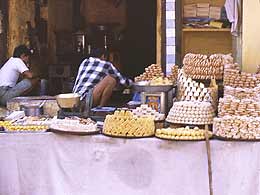 | ...When it is thick and solid they sell it as basic for making home sweets like gulab-jamuns... |
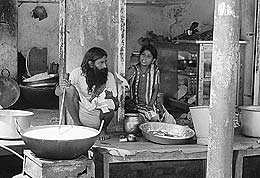 | ...In India, gulab-jamuns are traditionally fried from this thick milk instead of dough made of powder milk like in the West. |
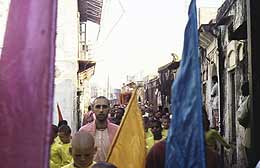 | Monkey on the roof is waiting for an opportunity to steal some banana or something glittering... |
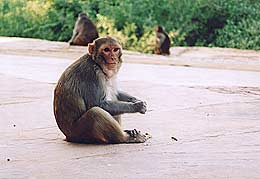 | ...Then it jumps like kamikaze for the fruit and before anybody realizes it is back on the roof. People usually laugh a lot except the fruit seller, generally. |
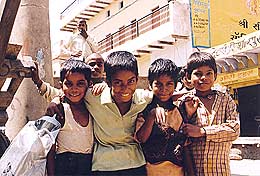 | The four brajavasi kumaras! |
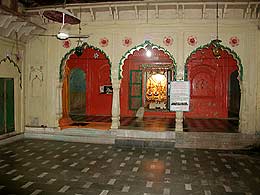 | Salagram-mandir
In this hidden temple located just next to Loi Bazaar... |
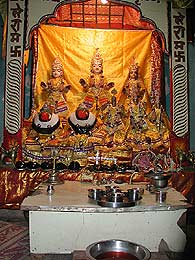 | ...there is a special altar... |
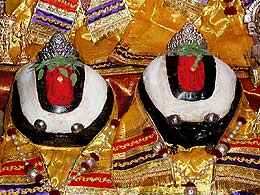 | ...with the greatest salagram-silas in the world. |
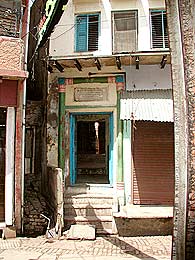 | Gaura-Nitai Temple of Murari Gupta
Murari Gupta was from childhood a great devotee of Lord Ramacandra. When he requested Sri Caitanya to allow him to make a Deity of Gaura-Nitai, Sri Caitanya told him to make them according to his own devotional taste... |
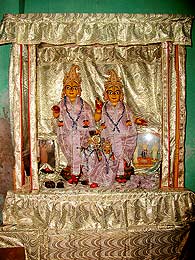 | ...These Deities are unique because They stand in tri-bangha form as Krisna and Balaram, Their hands are in the mudra of Ram and Laksman and Their hair is made up into topknot, just like Sri Caitanya and Nityananda in Navadvip. Murari Gupta was actually an incarnation of Lord's devoted servant Hanuman. A wonderful story about Murari Gupta's Gaura-Nitai Deities and Pisima Goswamini is here in this separate article. |
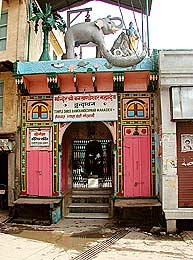 | Ban-khandi Mahadev Temple
While staying at Govardhan, Sanatan Goswami would take daily darsan of Cakaleswar Mahadev, and in Vrindavan he would go from his bhajan-kutir to take darsan of Gopiswar Mahadev. When he became too old, Mahadev appeared to him in a dream and told him: "Please do not undergo so much trouble seeing me. I shall manifest as Ban-khandi near your bhajan-kutir..." |
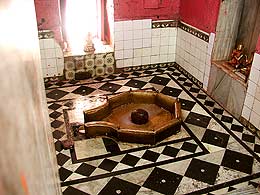 | ...Seeing Mahadev so mercifully manifested, Sanatan Goswami became overwhelmed with bhava. From that day on he would take daily darsan of Ban-khandi Mahadev before returning to his bhajan-kutir. |
 | Seva-kunja (Nikunjavan)
In this garden Radha and Krisna perform Their eternal lila every night. Therefore each evening at sunset everyone leaves the grove. No one is allowed within the enclosure at night. The numerous monkeys that are here during the day also leave at night... |
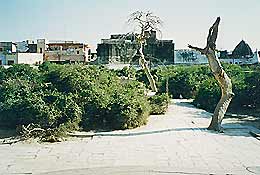 | ...Krisna would massage Radharani's feet and decorate Her hair with flowers here. There is no wonder that it is the place of topmost sacredness... |
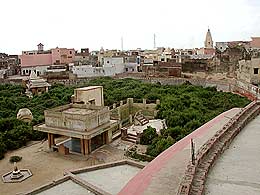 | ...Trees in the garden are not ordinary trees, they are said to be great sages, who wants to touch Radha's and Krisna's lotus feet and their branches are heading downwards near the ground. Seva-kunj is the place of most intimate pastimes of Divine Couple and it is surcharged with spiritual atmosphere... |
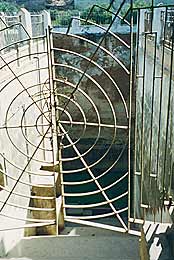 | Once Krisna pushed his flute into the ground here and created a small kund, called Lalita Kund, to satisfy Lalita Sakhi's thirst. The well is still there within the central part of the garden. |
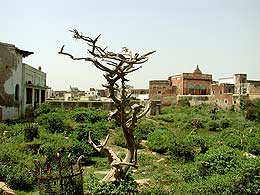 | Next to Seva-kunj, separated by wall, there is adjoining garden called Kisori-kunj or Kisori-van. |
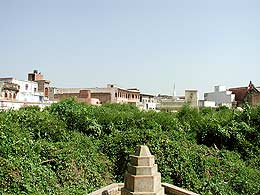 | In 1516 Rupa and Sanatan arrived in Vrindavan. Lord Caitanya ordered the two brothers to uncover the places of Krisna's pastimes. They lived austerely, halting for each night under different tree... |
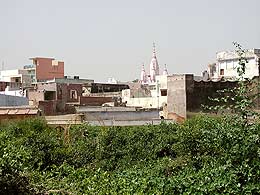 | ...By their inner vision as Sri Rupa Manjari and Labanga Manjari they revealed the sites of Krisna's sporting for the benefit of others. "Vrindavan is a gift of Rupa and Sanatan Goswamis," Srila Prabhupada used to say. For short periods they stayed at selected places... |
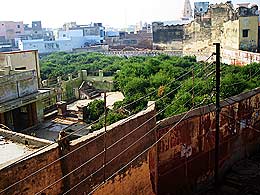 | ...Rupa Goswami performed his bhajana at Ter Kadamba (near Nandagram), Varsana, Radha-kund and Seva-kunj. Their bhajan-kutirs were not brick or wooden structures, but a temporary arrangements like hollow of a tree, a clearing under a thorny ticket, or an underground cave. Jiva Goswami spent some time in Nanda-ghat in a vacant crocodile hole... |
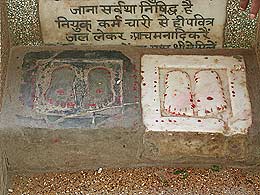 | ...In these austere natural settings Rupa and Jiva chanted harinam and wrote the most exalted and sublime transcendental literature about the intimate affairs of Radha and Krisna. Sanatan would sleep only two or three hours and at night he would burn dried leaves and with that light he would write his books... |
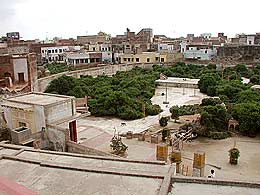 | ...At that time Vaisnavas were writing their book on palm leaves, bark or even old Deity dresses. The Goswamis, however, used hand made paper donated by kindly Jaipur kings... |
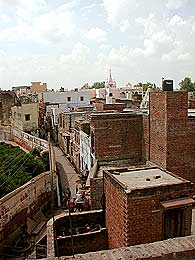 | Rupa Goswami didn't take any land or any deed. Seva-kunj was than a large area. There were no temples, no buildings, no construction, nothing. The emperor's landlord, who owned the area, was thinking 'I am so fortunate that Rupa Goswami is living here on my land.' |
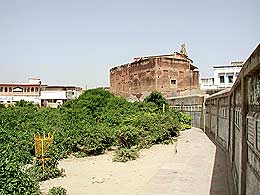 | With Sanatana Goswami's disappearance in 1588, Jiva Goswami officially purchased the land, to preserve Seva-kunj for the Gaudiya-vaisnavas. Seva-kunj is a special sacred place for many reasons. Here, Sanatan Goswami worshipped his beloved Madanmohan Deity and later entered samadhi. Supreme Lord Damodar appeared ere to accept service from Sri Rupa and Sri Jiva Goswamis. |
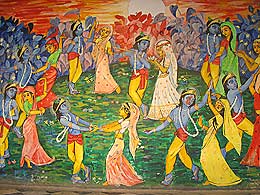 | Many famous Vaisnavas lived here and attended Rupa Goswamis realized discourses on prema bhakti. And most significantly, within Seva-kunj, Sri Syamasundar eternally enjoys pleasure pastimes with Srimati Radharani and the gopis. |
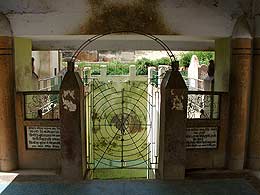 | For thirty rupees Jiva Goswami bought the plot from Emperor Akbar's landlord Ali Kant Chaundhari. The tract encompassed Seva-kunj, Dan-gull, Imli-tala, Sringar-sthali and Rasa-sthali. Its boundaries were marked by four trees: tamarind, banyan, pipal and kadamba. |
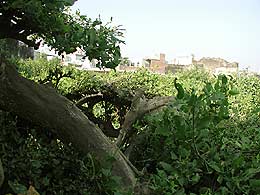 | ...Being the youngest, Jiva Goswami inherited many of the elder Goswami's writings, Deities, properties and temples. He personally managed the temples of Madanmohan, Govindaji, Gopinath and Damodarji... |
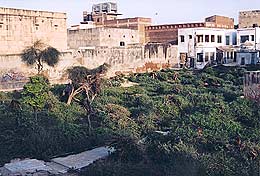 | ...At the request of Raghunath das Goswami he assisted in excavating of Radha-kund and was the supervisor of his will. Although he was a leader of gaudiya-sampradaya, he always consulted important matters with other Vaisnavas... |
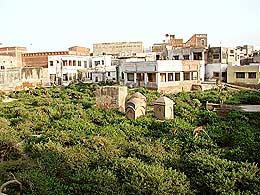 | ...In 1582 he called a meeting to Radha-Damodar and together with Gopal Bhatta Goswami, Raghunath Bhatta Goswami, Radha-Krisna Goswami and Haridasji decided to sent Srinivas, Narottam and Syamananda to preach to Bengal, Manipur and Orissa with the copies of Goswami's writings... |
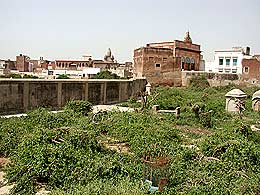 | ...In 1570, Moghul Emperor Akbar came to Vrindavan to meet widely acclaimed Goswamis. After receiving darsan of Nidhivan and Jiva Goswami, the Emperor was deeply impressed and reciprocated by erecting a library at Radha-Damodar Temple. Emperor Akbar, and adherent of religion and philosophy, once invited Jiva Goswami to his royal palace to debate about the ontological positions of Ganga and Yamuna rivers... |
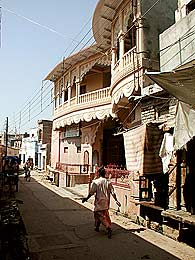 | ...Jiva declined because of his vow never to leave Vrindavan. He conceded, however, after the eight hearty horses and a promise of return by evening. Years later, Jiva Goswami praised Emperor Akbar in Govinda-mandir-astaka (carved on the walls of Radha-Govinda Mandir): "Emperor Akbar is a very kind hearted person and a Vaisnava. I give my blessings to Emperor Akbar. In his kingdom all the Vaisnavas are living very peacefully." |
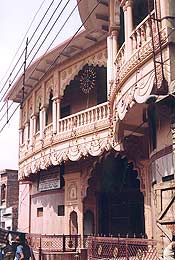 | Gaudiya Math near the entrance of Seva-kunj is the residence of Bhaktivaibhava Puri Maharaj, one of the disciples of Bhaktisiddhanta Sarasvati. |
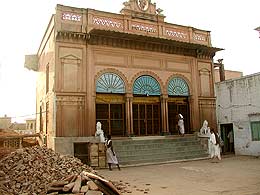 | Sita-nath Temple
Sita-nath is a Deity of Sri Advaita-acarya. "Nath" means "lord" and "Sita" is the wife of Advaita. "Sita-nath" therefore means "the lord of Sita", Advaita-acarya. |
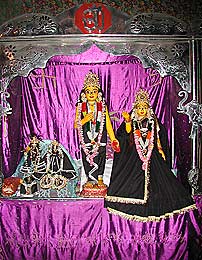 | Advaita-acarya is an incarnation on Sada-Siva and Maha-Visnu and He is the close associate of Sri Caitanya Mahaprabhu... |
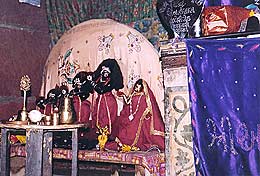 | ...He appeared prior to Lord Caitanya and by His calling and prayers made Sri Caitanya to appear. |
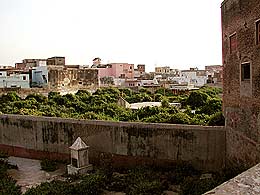 | From the courtyard one can see both Seva-kunj (right) and Kisori-kunj (left). |
 | Paurnamasi Temple
Paurnamasi is an incarnation of Krisna's internal potency Yogamaya. Brajvasis consider Paurnamasi their guru as she plays important role in arranging of loving pastimes of Radha and Krisna. Original deity of Paurnamasi is at Sanket, between Nandagram and Varsana. |
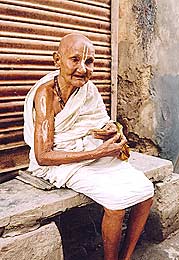 | Passing by this old Vaisnavi... |
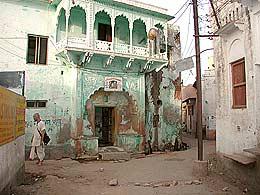 | ...we came to this temple... |
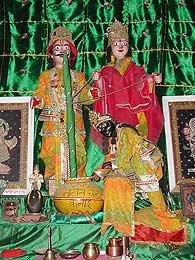 | ...where baby Krisna steals butter... |
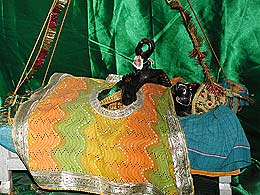 | ...and suck His toe. |
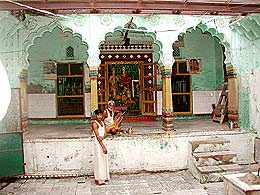 | They are probably the only Deities in Vrindavan depicting those pastimes. |
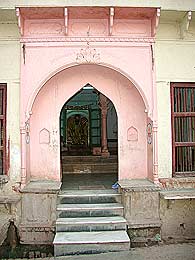 | Nrsimhadev Temple
On the way to Radha-vallabha Mandir there is a temple of one of the few Nrsimha Deities in Vrindavan. |
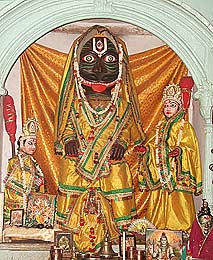 | Sri Nrsimhadev is carved out of wood and Laksmi and Prahlad Maharaj are to His sides... |
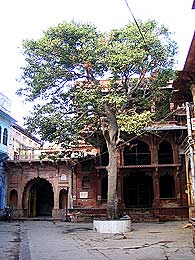 | Radha-Vallabha Temple
The original temple of Radha-Vallabha (right) was desecrated by Muslims in 1670 and a new temple was constructed next to it (left entrance). Original murti is now worshipped in this new temple. |
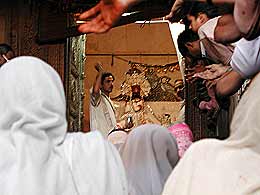 | Sri Hitahari-vamsaji received Radha-Vallabha Deity as a dowry at his wedding... |
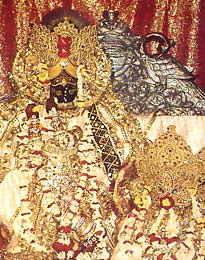 | ...There is no vigraha of Srimati Radharani and a crown is worshipped on the altar instead. Radha-Vallabha Deity is extremely beautiful. |
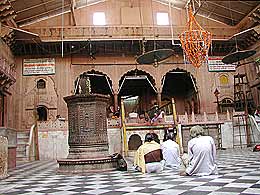 | In the same compound there are also temples of Radha Ananda-vallabha, Radha Jivan-vallabha and Radha Kisori-vallabha. |
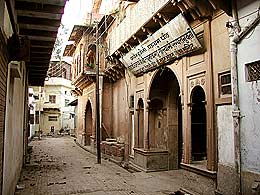 | Bhattaji Mandir
Near Radha-Vallabha Temple there is another Madanmohan Mandir where personal Bhagavatam of Raghunath Bhatta Goswami can be seen. That is why it is called "Bhattaji" Mandir... |
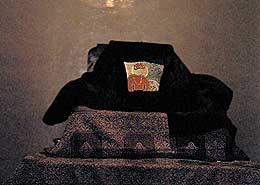 | Raghunath Bhatta was famous reciter of Srimad-Bhagavatam and as he chanted the verses in three different ragas, his audience would experience all kind of spiritual transformations. |
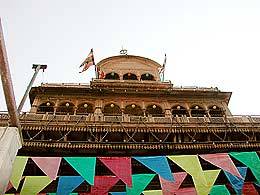 | Banki-bihari Temple
This temple was established by Haridas Swami, a contemporary of the six Goswamis. He found Banki-bihari Deity in Visakha-kund in Nidhivan. There is no mangala-arati in this temple. "Thakurji performs rasa-lila every night and goes to sleep early in the morning. It is improper to wake Him up so early," priests from the temple used to say... |
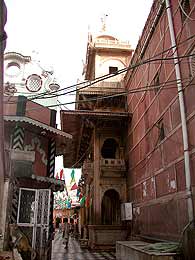 | Once a great devotee came to Banki-bihari Mandir and for a long time gazed at the Deity. Banki-bihari became so attracted to him that He went with him to his village. Goswamis of Bihariji find it out and after much pleading with both the devotee and Banki-bihari, brought Him back to the temple... |
 | ...After this incident a jhanki-darsan (momentary darsan) was introduced. The curtain before the Deities is not left open. Every few minutes the curtain is pulled shut and then opened again. This is just to make sure that no one will gaze at Him for a long time and bhakta-vatsala Banki-bihari will again leave a temple following His devotees. |
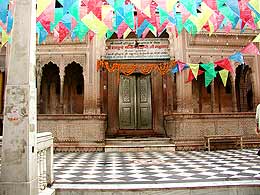 | During the Muslim oppression, Banki-bihari stayed secretly in Vrindavan and did not leave. Banki-bihari is the most popular temple in Vrindavan, especially in the month of Sravana, during Jhulan Yatra. |
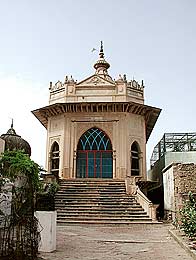 | Astha-sakhi Temple
This temple was built in 1912 by Ramranjan Cakravarti, the king of Hetampur form West Bengal. |
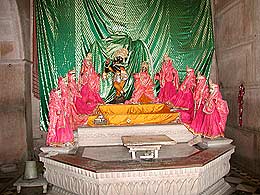 | His wife had a dream in which Sri Krisna asked her to built a temple of eight sakhis: Sudevi, Tungavidya, Indulekha, Visakha, Lalita, Citra, Campakalata and Rangadevi. In the center stands Radha-Rasabihari and four sakhis (maidservants) are on each side. |
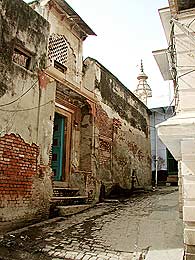 | The temple is near Madanmohan Mandir and to find entrance is a little tricky. |
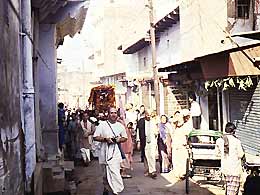 | Vrindavan has a small-town atmosphere with narrow streets and not much motor traffic. |
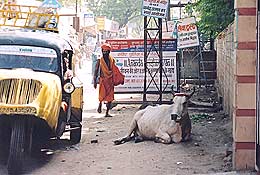 | Noisy tempo riksas can go no further than Bhaktivedanta Swami Marg stand. But recently other traffic is becoming a problem (2004). |
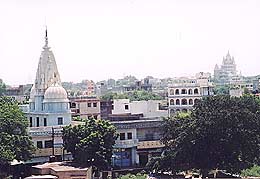 | On the road to Mathura there is an architectonically interesting... |
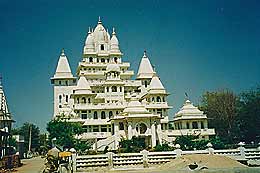 | ...Pagal-Baba's Temple. Pagal means "crazy" and people started to call this Baba in this way because he was smoking too much. |
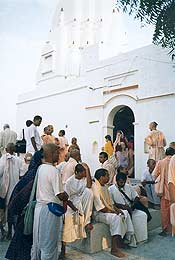 | Batharan-bihari Temple where Krisna's friends begged food from brahmana wives is near Akrura-ghat. Brahmanas wanted to be promoted to the heavenly planets and refused to give a food as a charity to cowherd boys (vaisyas) even if they asked in the name of Balaram (son of Vasudev and therefore ksatriya by birth). They would give it only to twice-born brahmanas, but their wives recognized through their devotion Krisna and Balaram and happily gave them what they could... |
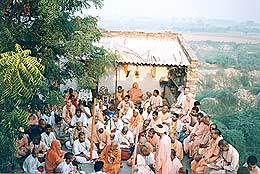 | ...The boys than sat at this spot and enjoyed wonderful preparations sent by wives of brahmanas. Therefore it is sometimes called Bhojan-sthali. |
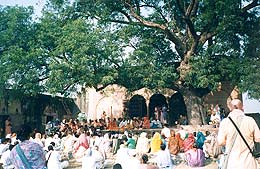 | Akrura-ghat
marks the border between Vrindavan (where Krisna as Yasoda-nandan performs His pastimes) and Mathura (where Devaki-nandan performs His pastimes). |
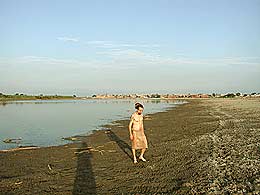 | A nice thing to do is to take bath little upstream of Yamuna River... |
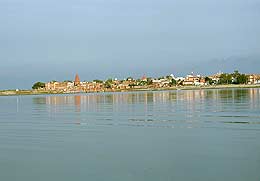 | ...and have a darsan of the whole city of Vrindavan from the water. |
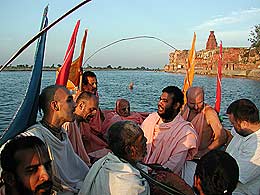 | Or even better is to take a boat, chant bhajans on the way to other side... |
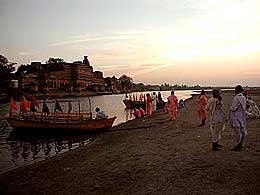 | ...make small puja for Yamunadevi,... |
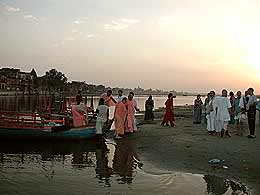 | ...take bath and come back at sunset. |
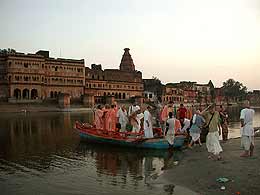 | My dear friend, if you still have any desire to enjoy the company of your friends within this material world, then don't look upon the form of Krisna, who is standing on the bank of Kesi-ghat (a bathing place in Vrindavan)... |
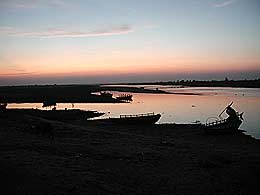 | ...He is known as Govinda, and His eyes are very enchanting. He is playing upon His flute, and on His head there is a peacock feather. And His whole body is illuminated by the moonlight in the sky." Srila Rupa Goswami,
Bhakti-rasamrita-sindhu |
 | O sakhi, this Vrindavan is spreading the fame of the Earth planet even above that of Vaikuntha because it is splendidly decorated by the marks of the lotus feet of Yasoda-nandana Sri Krisna... |
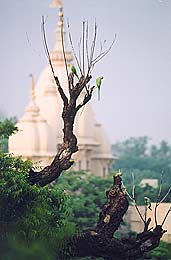 | ...Sakhi, when rasikendra Sri Krisna plays on His murali, which enchants the whole world, the peacocks become intoxicated and thinking the sound of the flute to be the roaring thunder of the clouds, spread their tail feathers and begin to dance. Seeing this, the birds and animals roaming on the mountain summits become completely stunned and relish the sound of the flute with their ears and the dance of the peacocks with their eyes.
Srimad-Bhagavatam 10.21.10 |
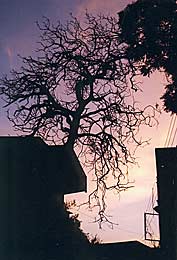 | Aho! In all three worlds, only Sri Vrindavan and the gopa-ramanisliving there are fortunate, because in that place the parama-purana-purusa Sri Krisna, disguised as human being, performs human-like pastimes under the arrangement of Yogamaya. Adored with a multi-colored vana-mala, He grazes the cows with Baladev and the sahkas, vibrating the sweet flute and absorbed in various kinds of krida-vilas.
Srimad-Bhagavatam 10.44.13 |

Nenhum comentário:
Postar um comentário